Buffalo MiniStation Thunderbolt (500GB) - Dual-Interface Portable HDD
The Buffalo MiniStation Thunderbolt has brought a breath of fresh air for portable hard disk drives with its option for USB 3.0 and Thunderbolt interfaces. Read on to find out if Thunderbolt can deliver better than USB 3.0 for a typical HDD based external drive.
By Wong Chung Wee -
Dual Interfaces on a 2.5-inch Portable HDD
Since the introduction of USB 3.0 in 2008, there have been a slew of portable 2.5-inch, SuperSpeed USB 3.0 based storage drives that offer a variety capacity points while offering transmission speeds up to a maximum of 5Gbps, which can give you up to 400MB/s in actual usage. The capability to reach this super fast speed greatly depends on the actual storage medium. As such, solid state drive (SSD) based solutions rather than those using standard hard disk drives stand to benefit from the interface's full potential.
Buffalo has up the ante with the introduction of Thunderbolt technology with its Buffalo MiniStation Thunderbolt. This drive features both Thunderbolt technology and USB 3.0 interface. Its Thunderbolt feature has broken the monotony of what is currently available and underscores the pioneering spirit of Buffalo to bring the latest technology to its portable storage solution. There is one catch that could be holding it back and that's the drive used within its enclosure which is not an SSD, but rather it's rather standard 5400RM based hard disk drive. Such drives are far from even breaching USB 3.0's capability, let alone Thunderbolt.

The Buffalo MiniStation Thunderbolt drive attempts to cater to the cutting-edge mainstream crowd with its dual-interface offerings coupled with a standard internal notebook hard drive. The Thunderbolt interface is for consumers who wants to future-proof their portable HDD investment while its USB 3.0 interface makes it possible for the drive to be used with any existing systems with USB 2.0 or 3.0 ports.

The USB 3.0 interface is on the left while the Thunderbolt interface is on the right.

The LED glows unobtrusively from its underbelly, indicating the drive is in operation.
According to most marketing literature we have read, this new interconnect technology is twice as fast as USB 3.0. With this figure in mind, we have put this drive through our suite of benchmarking software to ascertain if the Buffalo MiniStation Thunderbolt is capable of achieving such performance levels and if it's worth the extra cost. The drive is available in two capacity points - 500GB and 1TB. We're reviewing the 500GB edition in this article along with a couple of comparison products.
Model | Buffalo MiniStation Thunderbolt | Buffalo MiniStation Extreme | Western Digital My Book Thunderbolt Duo |
Interface Type | Thunderbolt and USB3.0 | USB 3.0 | Thunderbolt |
Capacity | 500GB / 1TB | 500GB / 1TB |
|
Supplied Cable Length(s) | USB 3.0 Cable (50.8cm) Thunderbolt Cable (52.2cm) | Built-in (15cm) and extension (50cm) | Not Supplied |
LED Activity Indicator | Yes | Yes (Orange for USB 2.0, blue for USB 3.0) | Yes |
HDD Specs - Rotational Speed | 5400RPM | 5400RPM | 5400 - 7200 RPM (IntelliPower) |
HDD Specs - SATA Support | SATA 3Gbps | SATA 3Gbps | SATA 6Gbps |
HDD Specs - Buffer Size | 8MB | 8MB | 64MB per HDD |
Shock Protection | - | US Military Grade Shock Protection | - |
Carry Case | - | - | - |
Security | - |
|
|
Software | - |
|
|
Dimensions | 80.5 x 130 x 23mm (W x H x D) | 89 x 128 x 18mm (W x H x D) | 99 x 165 x 157mm (W x H x D) |
Weight | 265g | 230g | 2150g
(2.15kg because it's a desktop product) |
Warranty | 3 years | 3 years | 3 years |
Price | S$279 / S$349 | S$119 / S$165 | S$899 |
Test Setup
Since the Buffalo MiniStation Thunderbolt has both USB 3.0 and Thunderbolt interfaces, we naturally tested both options to see how USB coped up against the newer interface on the same drive.
Given a lack of Thunderbolt-enabled devices to test, we had to include the Western Digital My Book Duo as a comparative note. It is essentially a Thunderbolt-enabled enclosure with a pair of WD Caviar Green (model WD30EZRX) 3TB SATA 6Gbps desktop HDDs. We understood that this particular HDD already outclassed the one found in Buffalo MiniStation Thunderbolt; hence, we already had expectations that the desktop storage drive will outperform the portable drive though they both feature the same new speedy interconnect technology. Our new system that has onboard support for Thunderbolt technology has the following system specifications:
- Intel Core i7-3770K @3.5GHz
- ASUS P8Z77-V Pro/Thunderbolt (BIOS Version: 1406)
- 2 x 2GB Kingston HyperX DDR3-1600 (CAS 9-9-9-27)
- MSI N460GTX Hawk (ForceWare 285.62)
- Western Digital Caviar Black 1TB SATA 6Gbps hard drive (one single NTFS partition)
- Windows 7 Ultimate 64-bit
- Intel INF 9.3.0.1020
Take note that the WD My Book Duo device can be configured for RAID 0 or RAID 1; however, the software utilities for doing so, is only supported on Mac OS X. Hence, on our Windows 7-based testbed, we were only able to test one of the WD Caviar Green HDDs in a non-RAID environment. On our test system, we were able to see the two physical HDDs as a pair of logical drives in our Windows environment. As such, the comparisons we've made in the test results sections are well aligned (apart from the fact that we're comparing a notebook-class drive against a desktop-class drive) since we're comparing single disk drive performance. .
We also picked the best drive from our 2.5-inch 1TB portable hard disk drive shootout for comparison with the drives from the Thunderbolt camp. That drive is the Buffalo MiniStation Extreme. The shootout was conducted on our usual storage testbed that has the following system specifications:
- Intel Core i5-2400 (3.1GHz)
- MSI Z68A-GD80 (Intel Z68 chipset)
- 2 x 4GB DDR3-1600 memory
- MSI GeForce 8600 GTS
- Windows 7
The list of drives tested are as follows:
- Buffalo MiniStation Thunderbolt (500GB)
- Western Digital My Book Duo (2 x WD Caviar Green 3TB SATA 6Gbps HDD, but benchmarking conducted on a single drive)
- Buffalo MiniStation Extreme (1TB)
The list of benchmarks used are as follows:
- AS-SSD benchmark 1.6.4
- HD Tune Pro 4.6
- CrystalDiskMark 3.0.1
- PCMark 7
- PCMark Vantage
- Iometer (version 2006.07.27)
AS SSD Results
This benchmark is usually used to benchmark SSDs as it uses non-compressible and completely random data to tax the various drive controllers. This prevent SSDs that feature certain controllers from using data compression to gain an advantage over their competitors. Since this is our first foray into testing drives that feature Thunderbolt technology, we have decided to put these drives through the whole gamut of benchmarking software in our arsenal. Since the benchmark just dishes out a different set of data, it's still an applicable test, regardless of its name.
In this test, we pitted the Western Digital My Book Duo against the Buffalo MiniStation Thunderbolt with the latter tested on both USB 3.0 and Thunderbolt interfaces. The Western Digital drive performed better than portable drive from Buffalo for obvious reasons that stem from the completely different drive classes compared. As such, this outcome was to be expected.
In terms of reaching the promised land of better performance allegedly offered by Thunderbolt technology, we failed to see any pronounced difference in terms of the performance figures obtained on both interfaces from the Buffalo MiniStation Thunderbolt. It was only in the Copy Benchmark results that we witnessed the new interconnect technology's significant gains over USB 3.0. Its gains over the USB 3.0 interface scores were in the range of 13% to 23%, across the three components of the test.
It seems that the Buffalo MiniStation Thunderbolt drive leveraged on the dual-channel nature of Thunderbolt as it pushed ahead by slightly over 90% during the 4K Read test at 64 Queue Depth as compared to using the USB 3.0 interface. However, it failed to repeat this level of performance gain for the Write test.
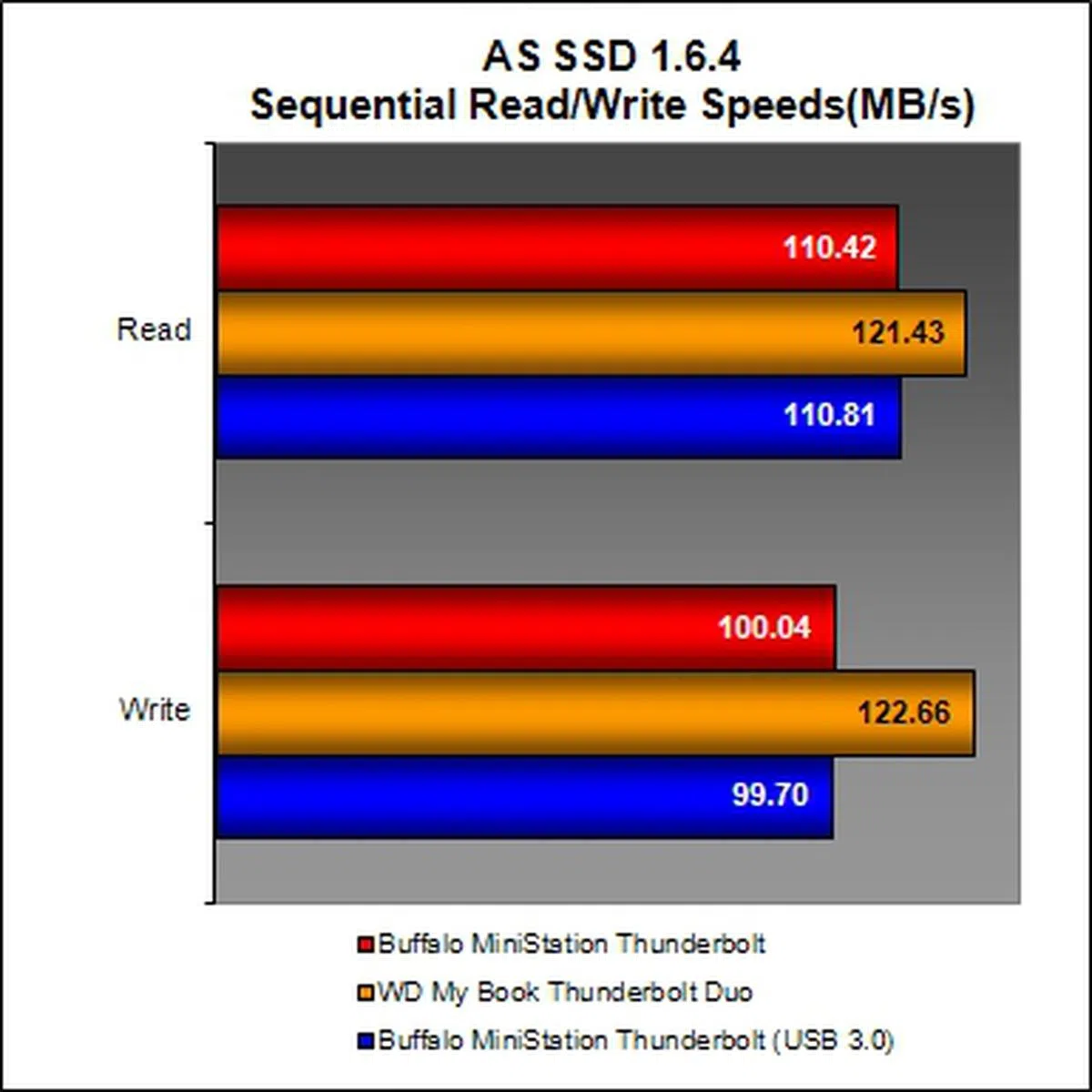 | 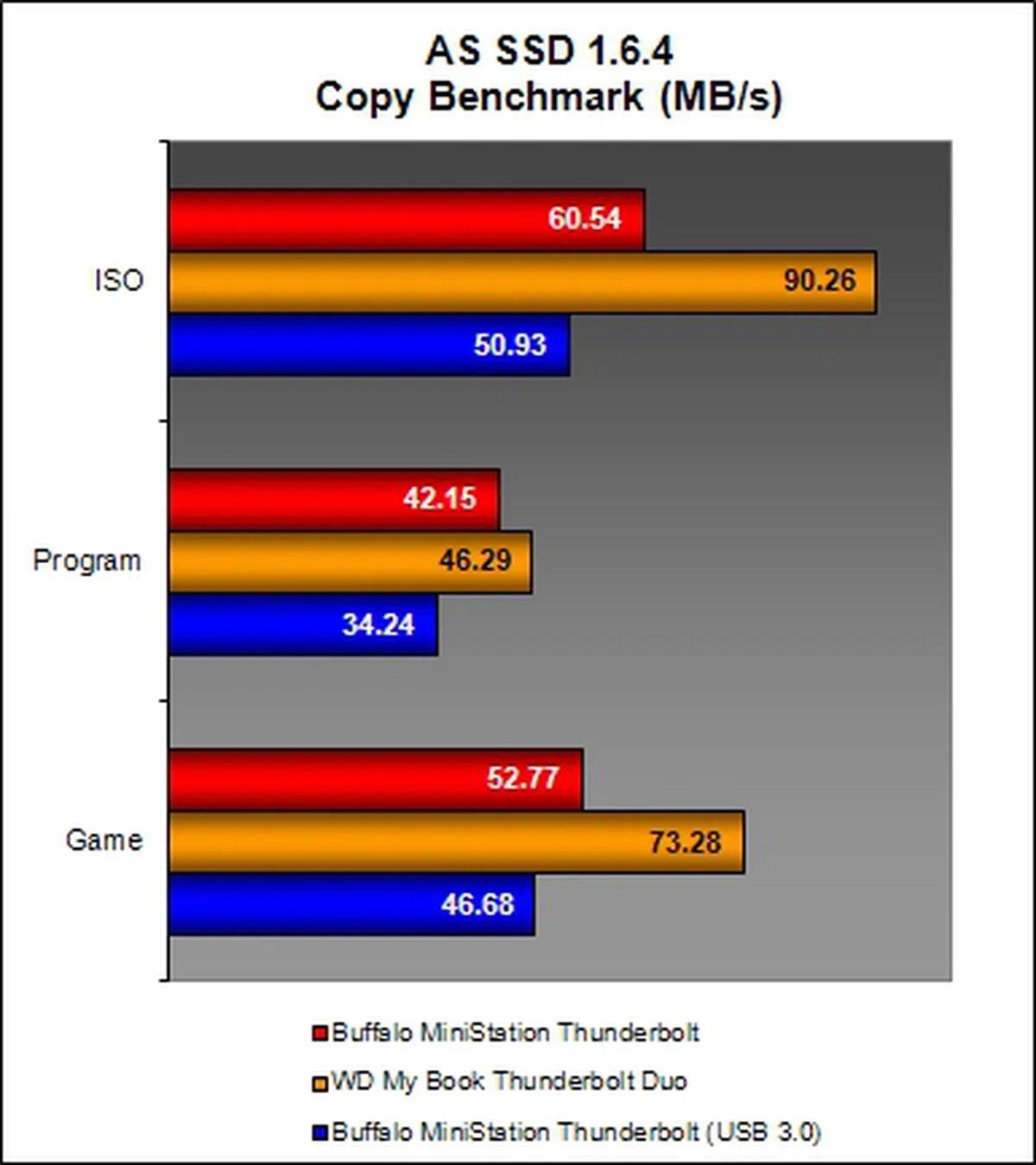 |
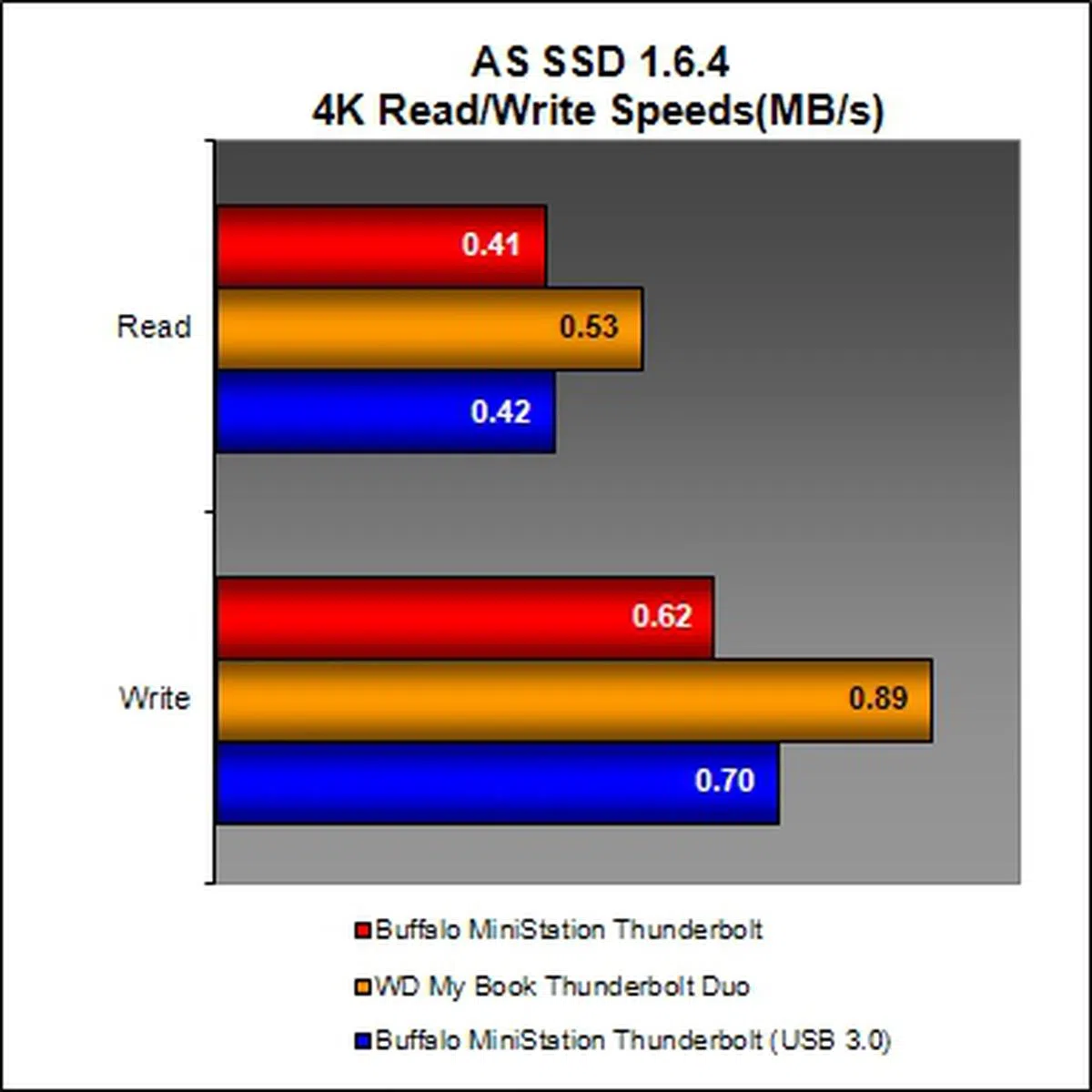 | 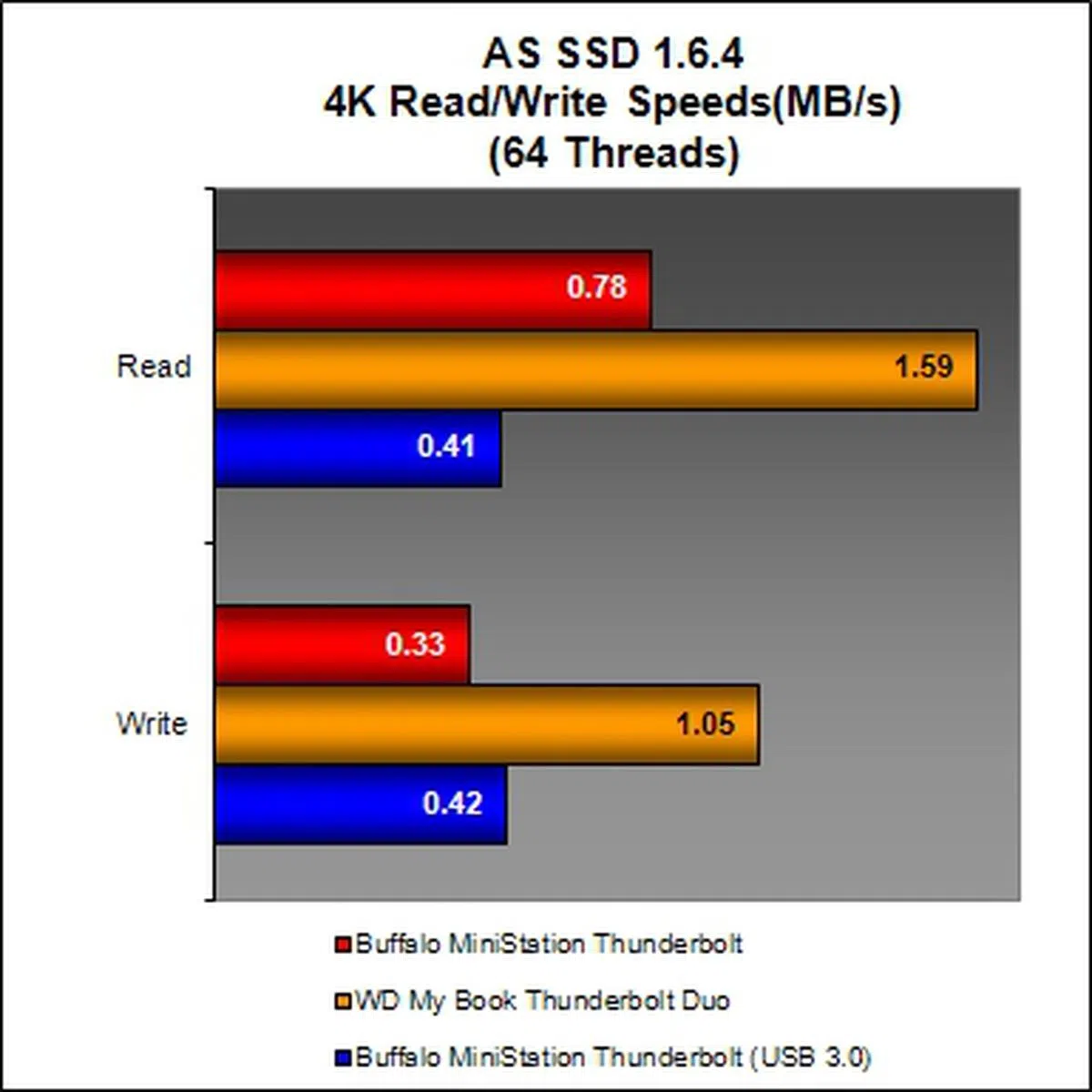 |
CrystalDiskMark 3.0.1 Results
This benchmark is designed for quick and easy testing of HDDs. It can measure measure sequential and random read/write speeds. In the sequential read/write tests, the Buffalo MiniStation Thunderbolt drive blazed ahead when it was using its USB 3.0 interface. Its Thunderbolt performance was strangely simiar to the Buffalo MinStation Extreme, the winner of our previous 2.5-inch 1TB portable USB 3.0 HDD shootout. The Buffalo MiniStation Thunderbolt's performance on its USB interface was in the range of 60% to 68% higher than the Buffalo MinStation Extreme.
For the rest of the CrystalDiskMark tests, the scores returned from the Buffalo MiniStation Thunderbolt tested on its USB 3.0 interface were higher than those from the Thunderbolt interface, with the exception of the read speed in 4K, queue depth 32 test.
Just as we observed earlier for the AS SSD test results, the Buffalo MiniStation Thunderbolt scored 19% higher over its USB 3.0 interface score during the 4K Read test at 32 Queue Depth; however, it similarly faltered at the Write portion of this test.
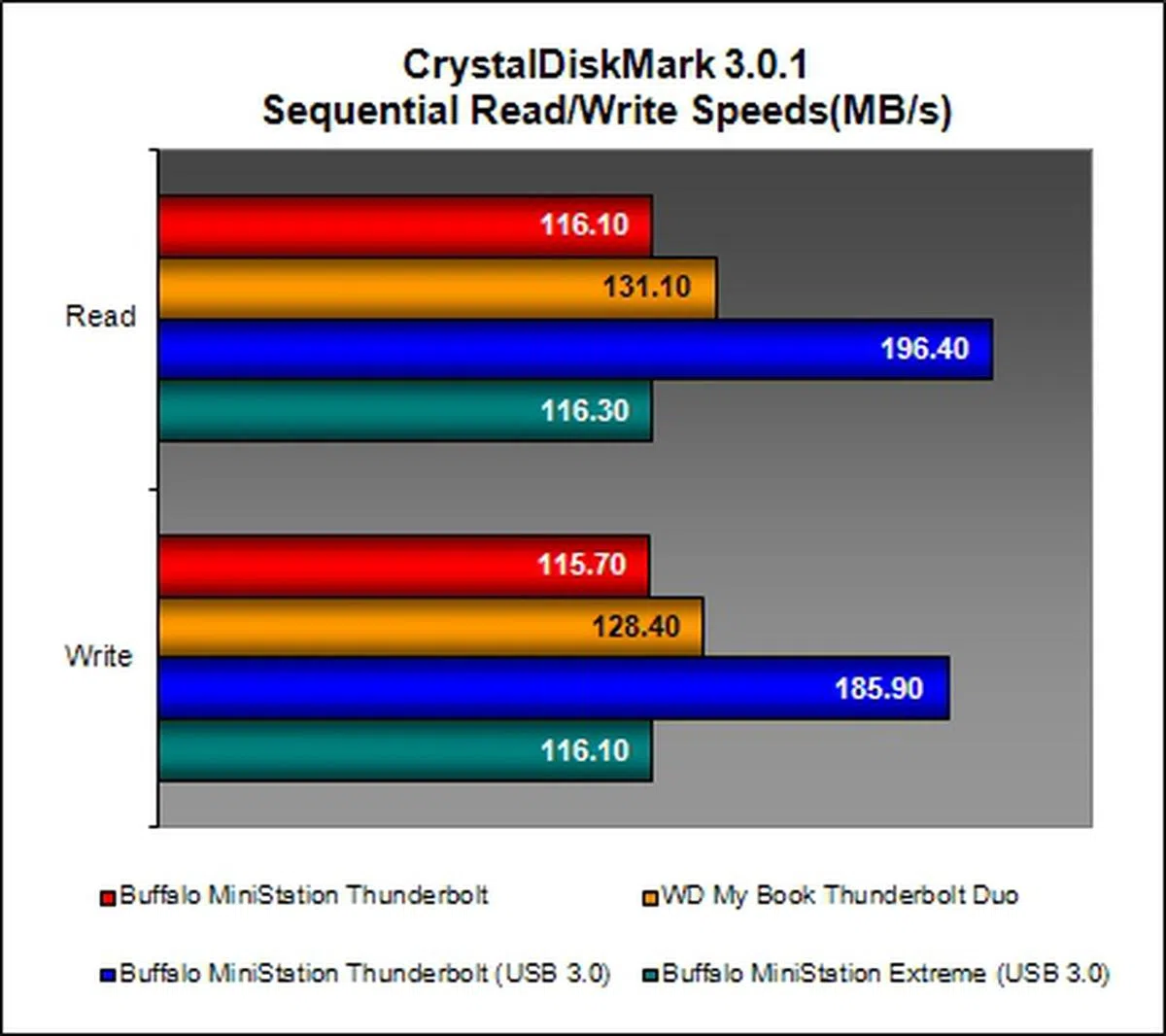 | 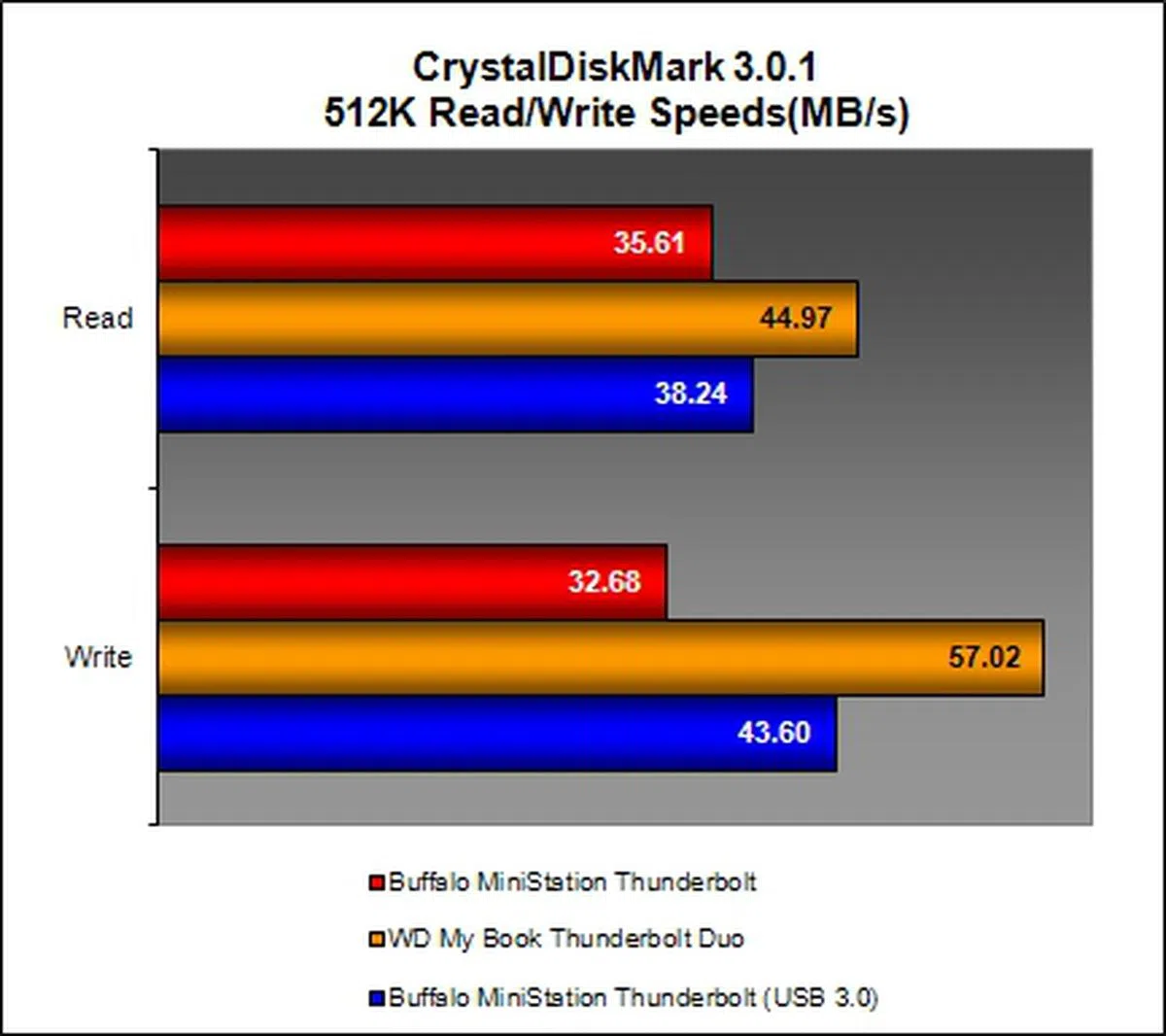 |
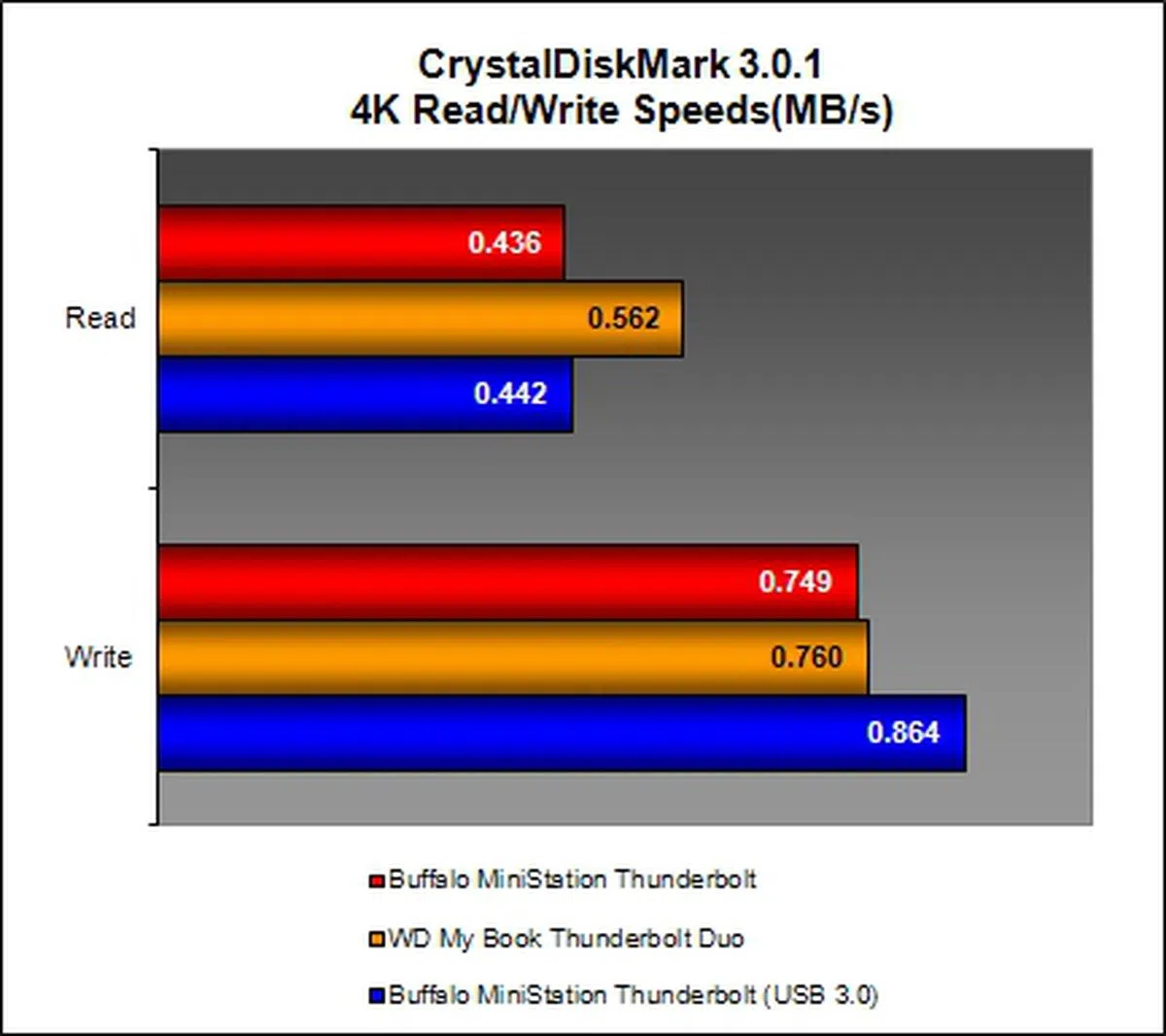 | 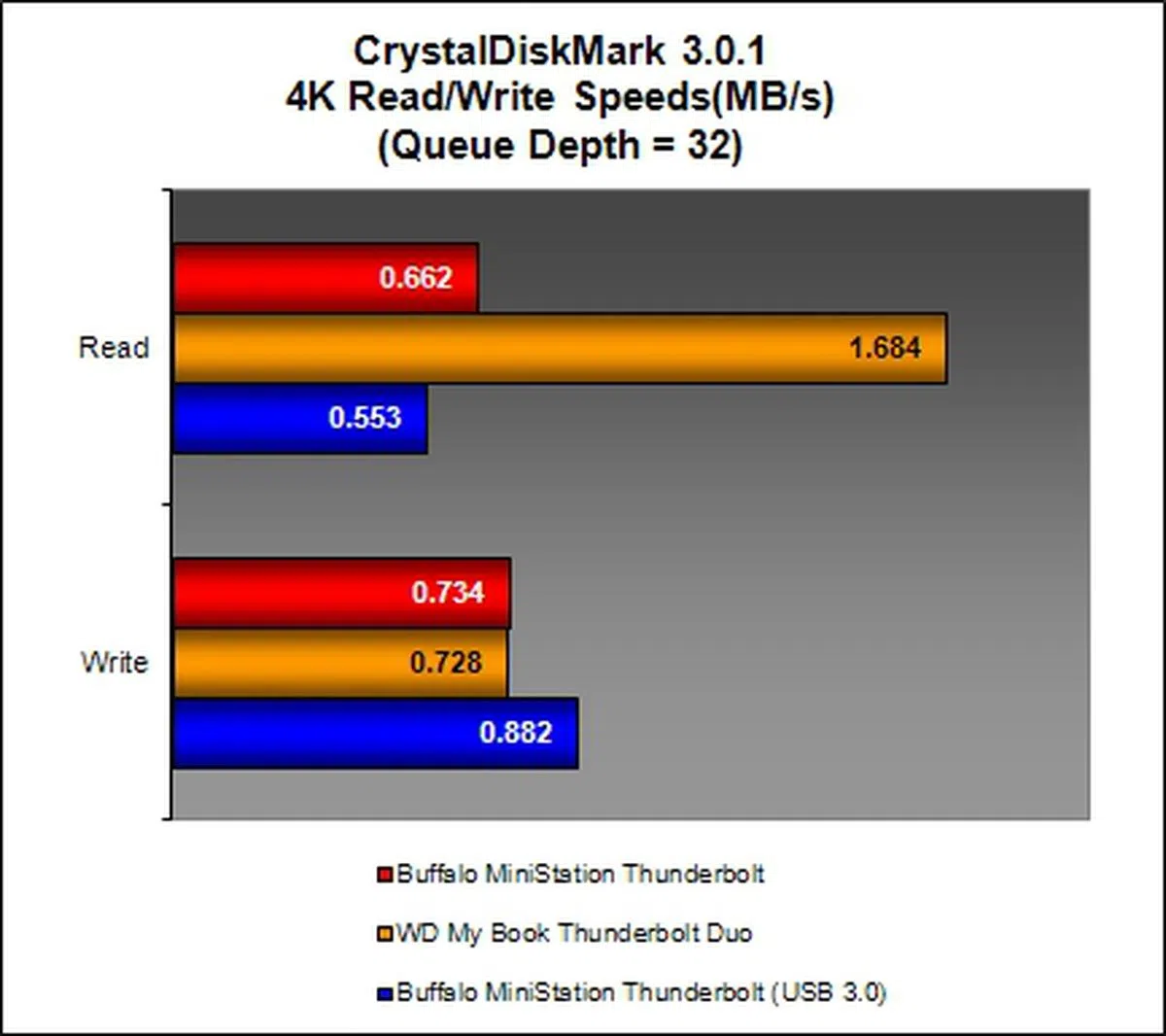 |
HD Tune Pro 4.6 Results
The Buffalo MiniStation Thunderbolt's performance (regardless of the interface used) during the Read test portion was similar to the Buffalo MiniStation Extreme.



The Thunderbolt interface of the Buffalo drive actually performed worse in the random average access timings and consequentially affected random average speed by about 10% than when using USB 3.0.
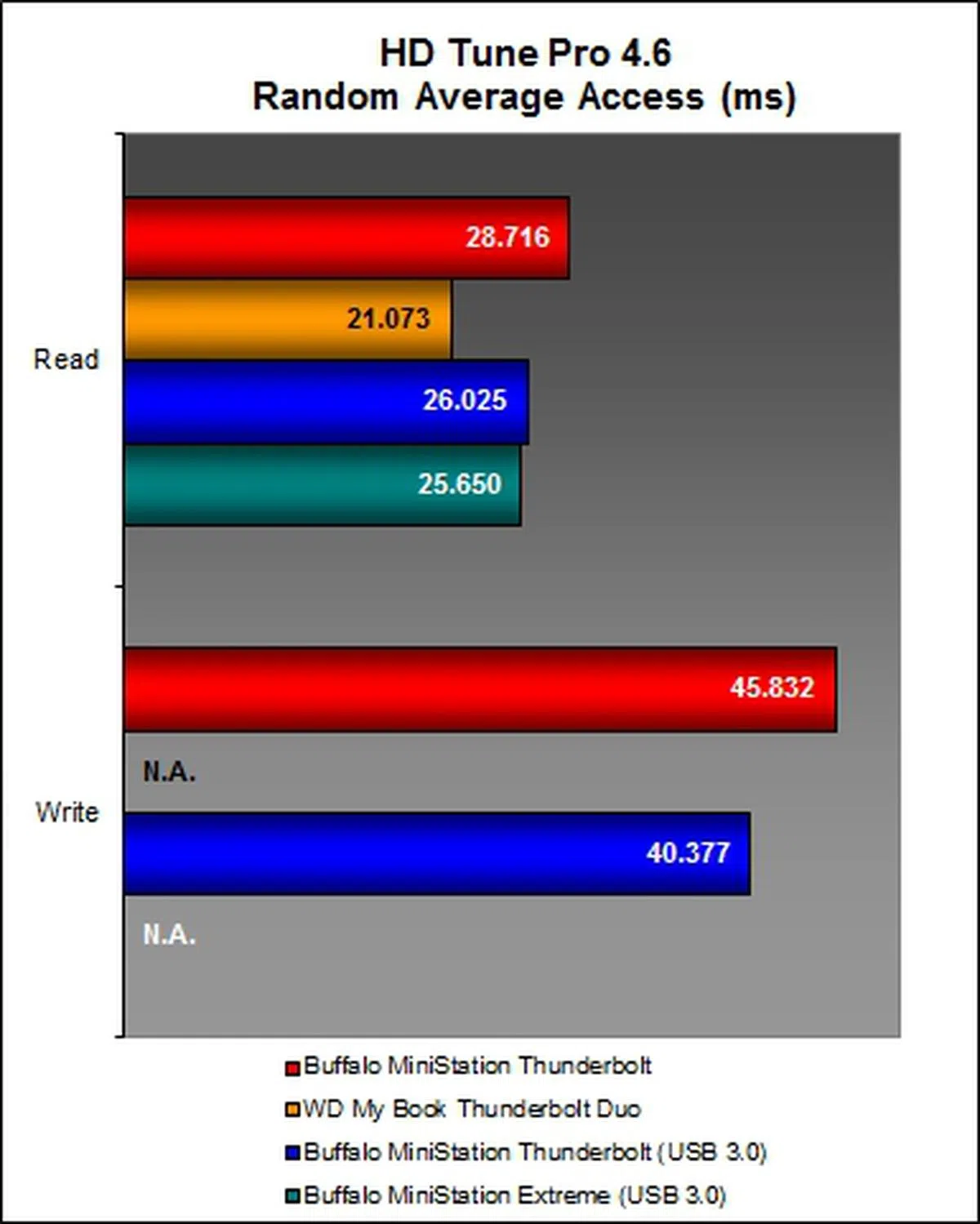 | 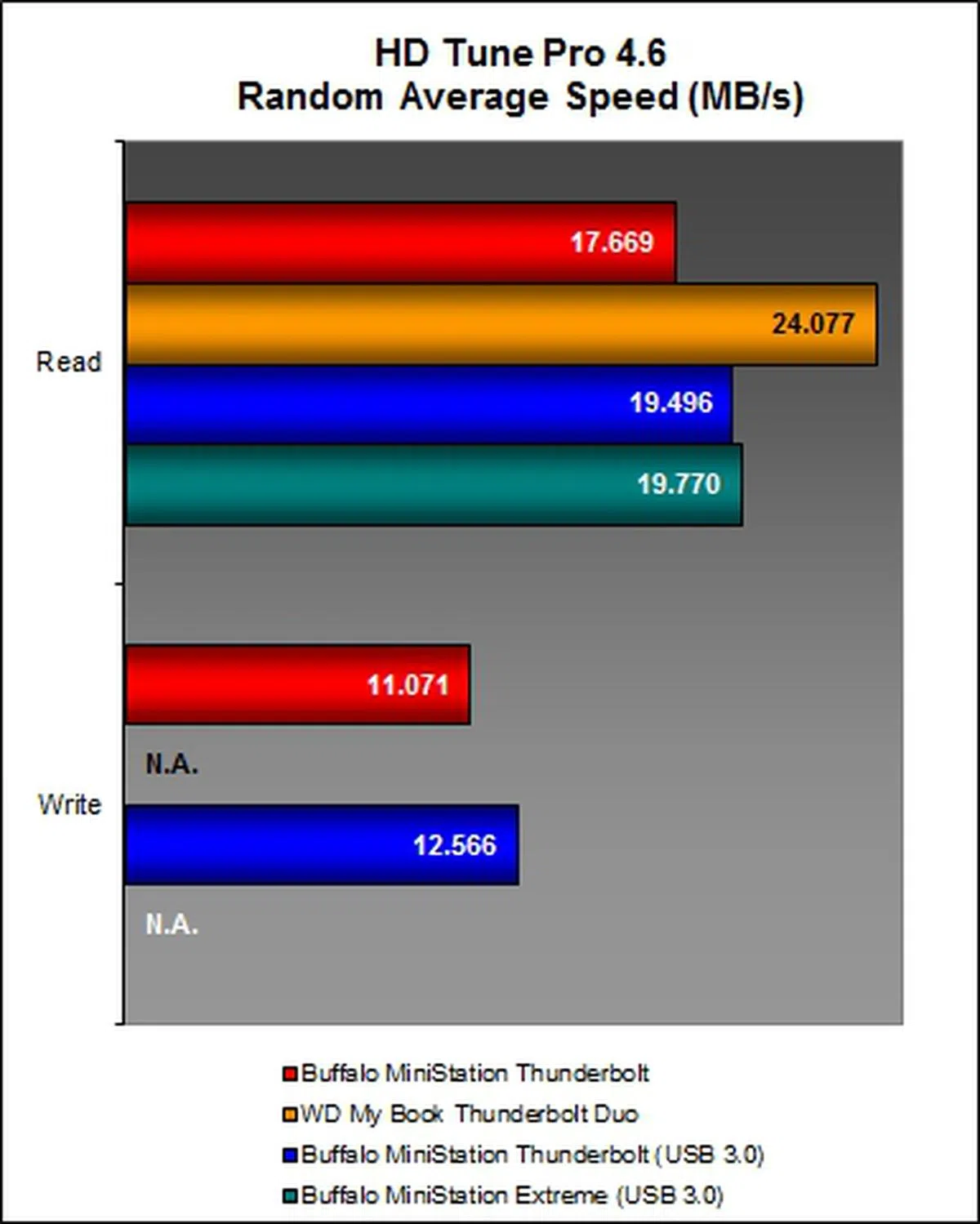 |
Futuremark PCMark 7 Results
For these set of results, the Thunderbolt feature of the Buffalo MiniStation Thunderbolt failed to point us in the direction of the promised land of doubled performance levels over USB 3.0. Clearly, the hard disk drive used within the unit isn't cut out to take good advantage of the interface.
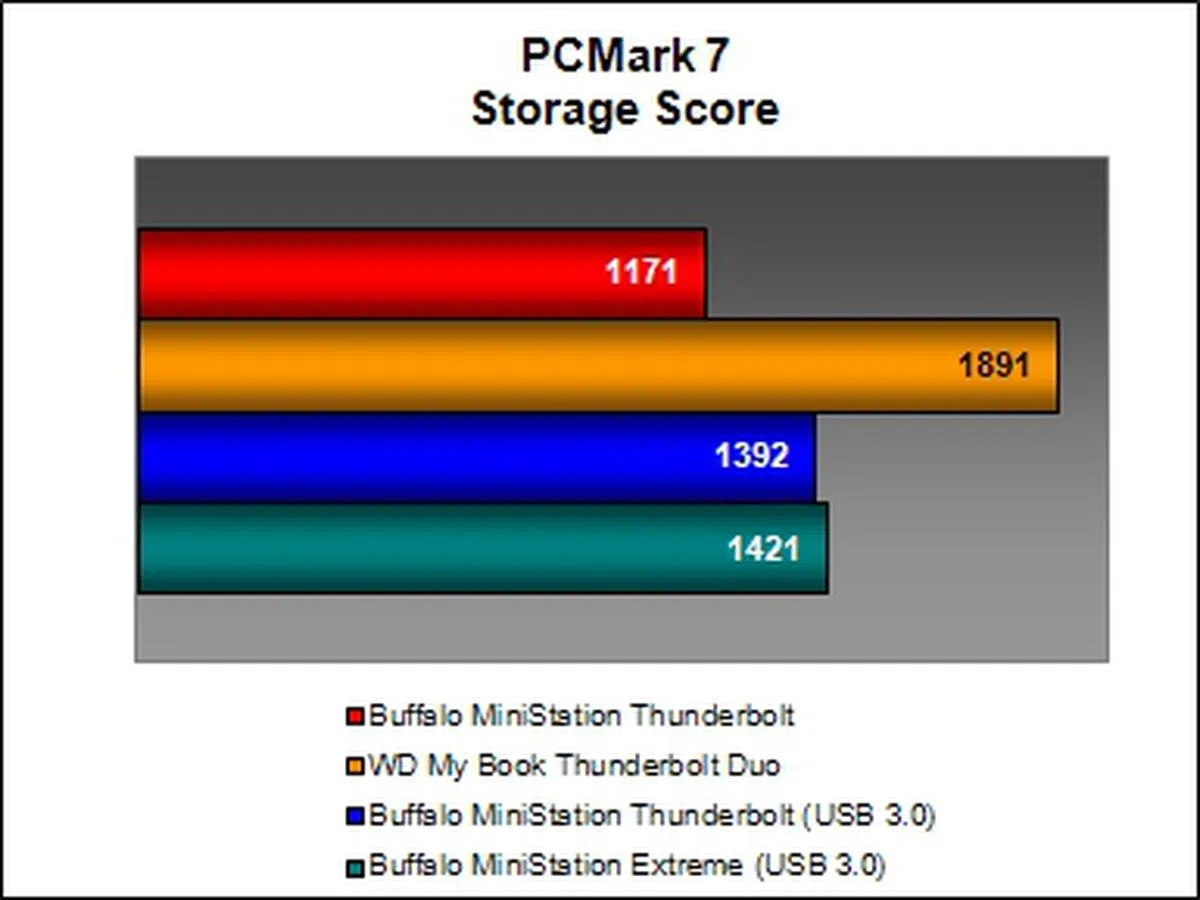 | 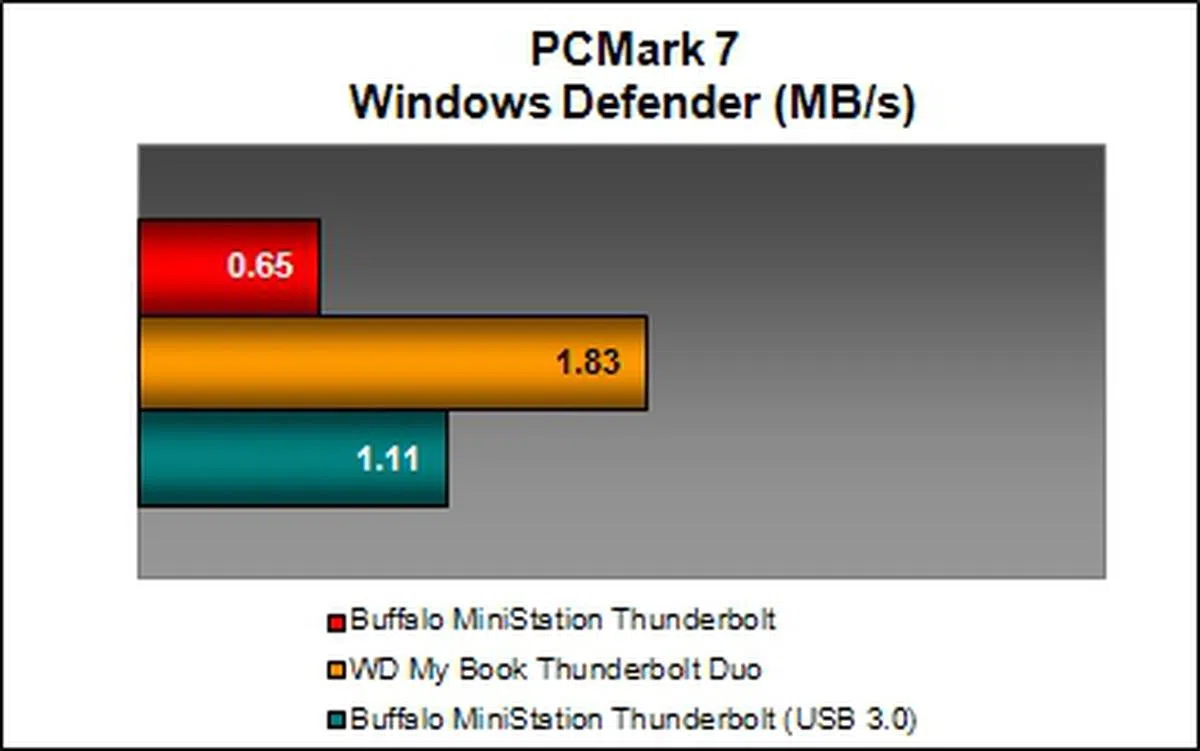 |
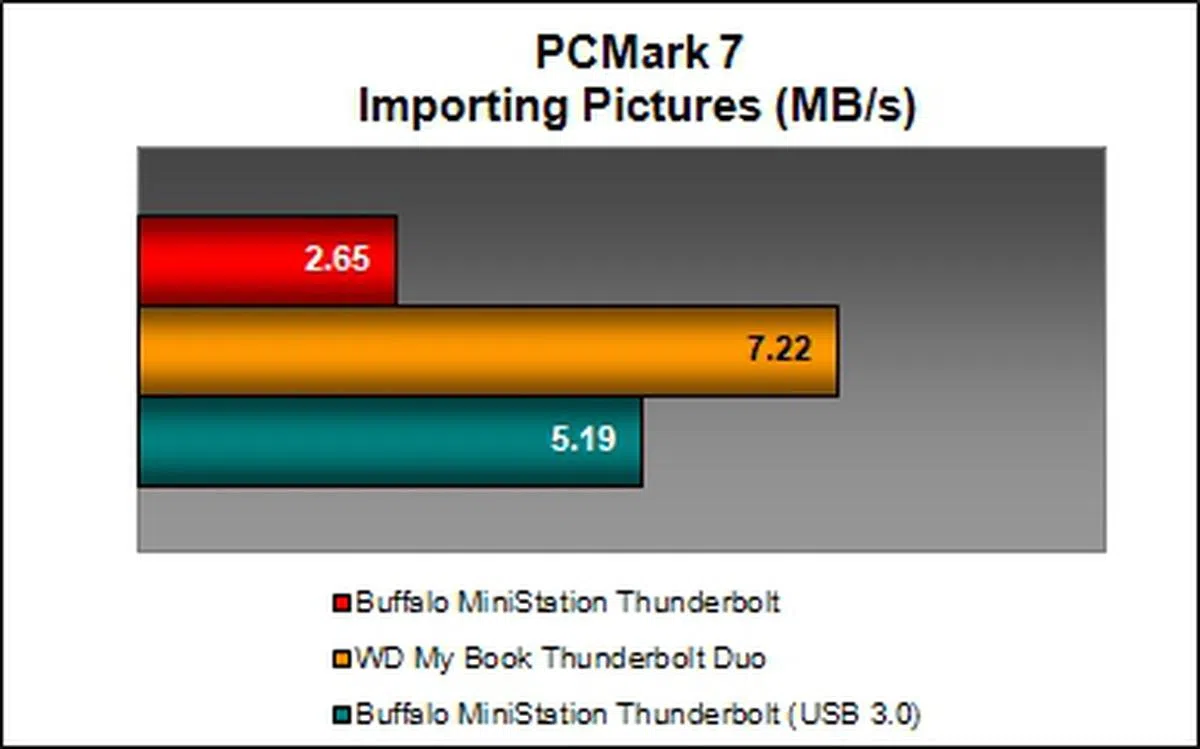 | 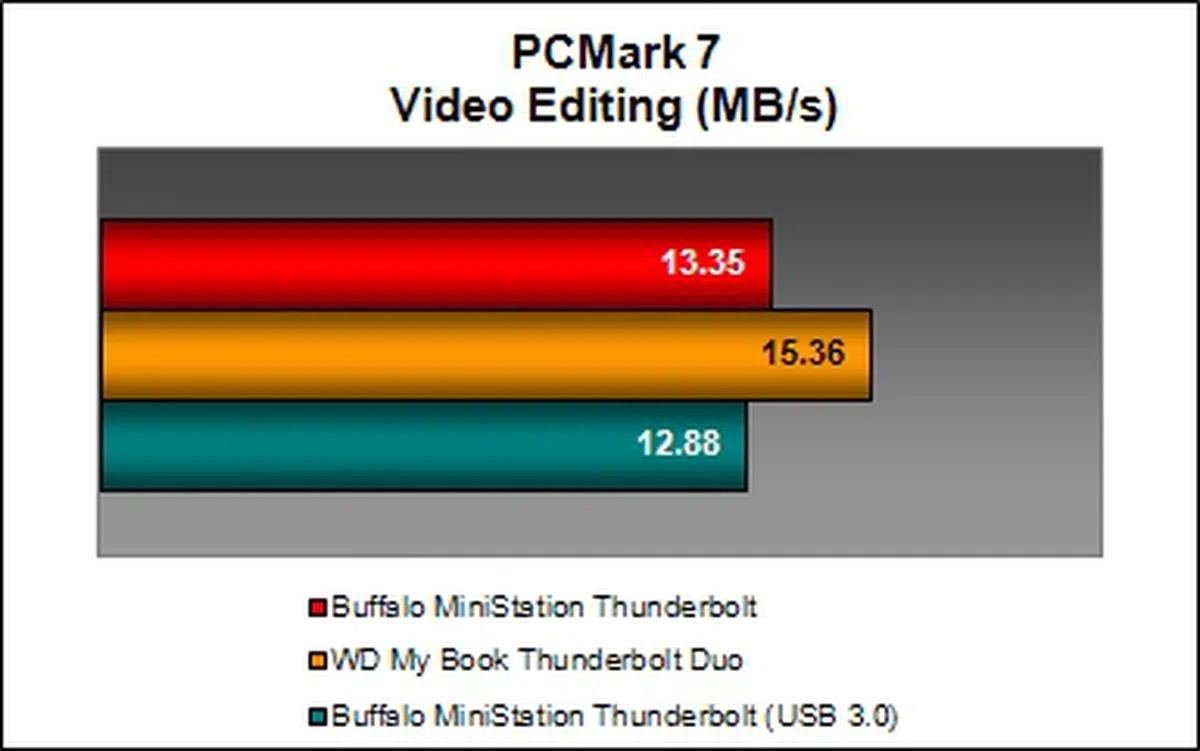 |
The only glimmer showed up when its score for the Windows Media Centre portion was almost 2% higher than the score turned in by the USB 3.0 interface.
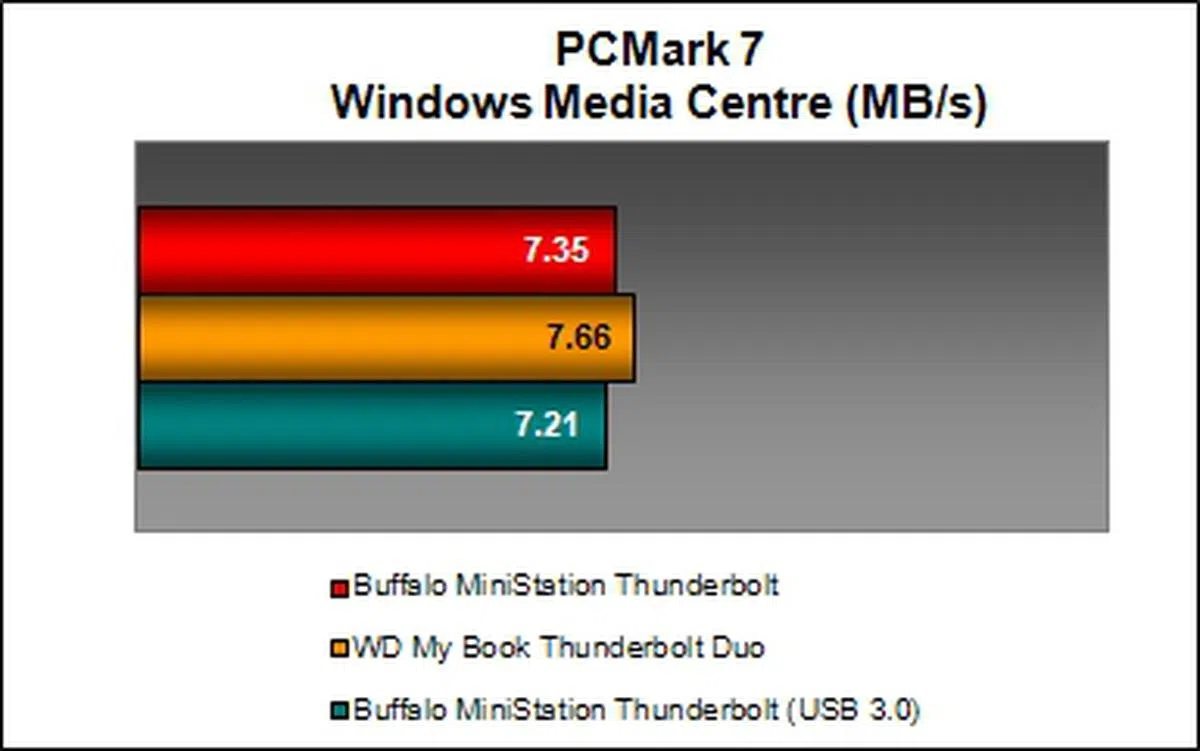 | 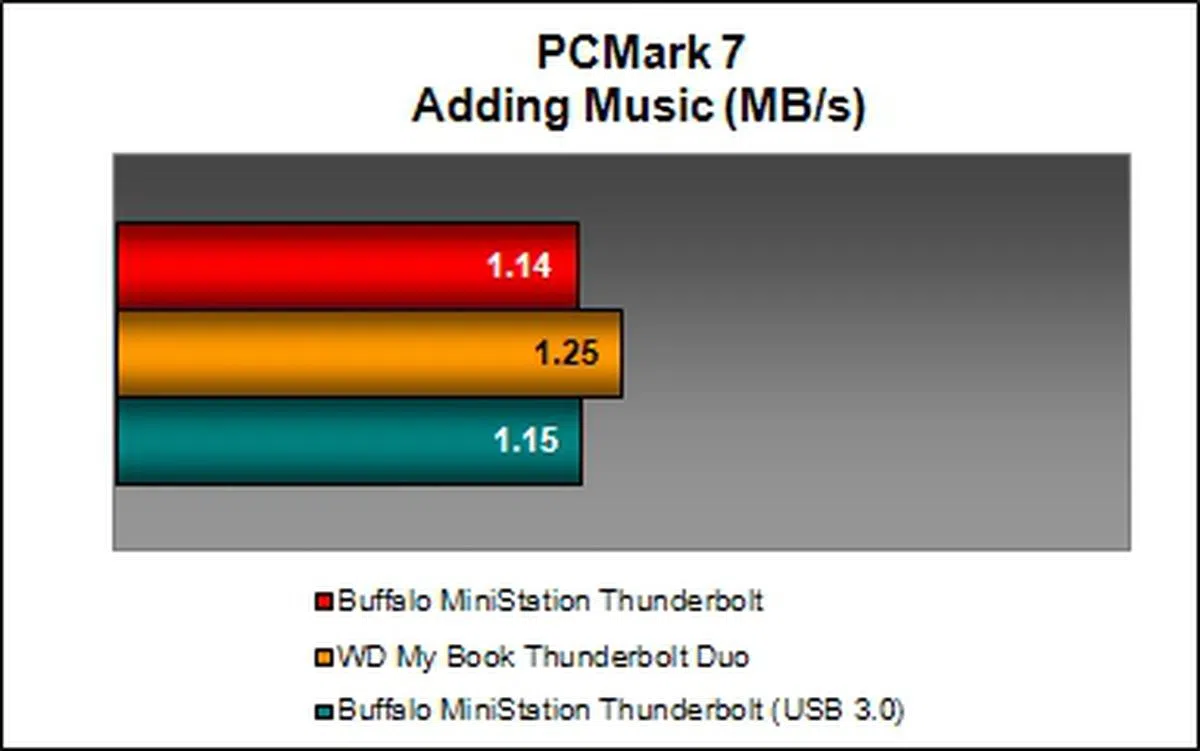 |
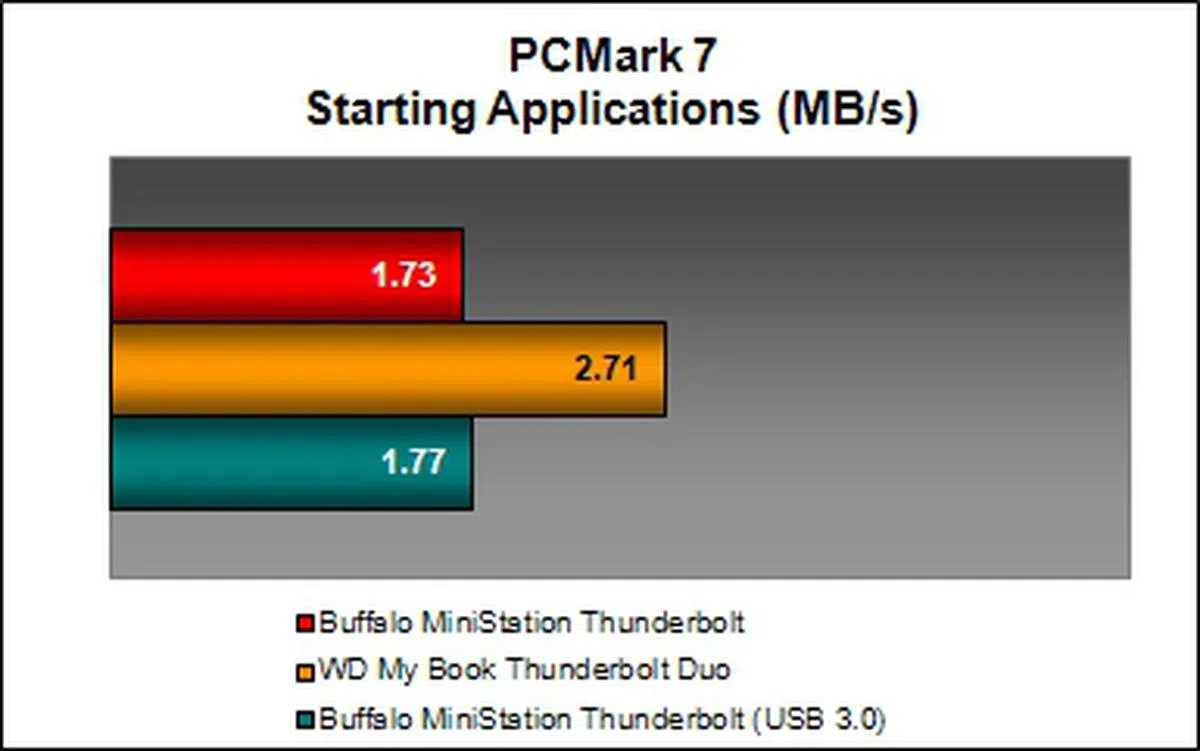 | 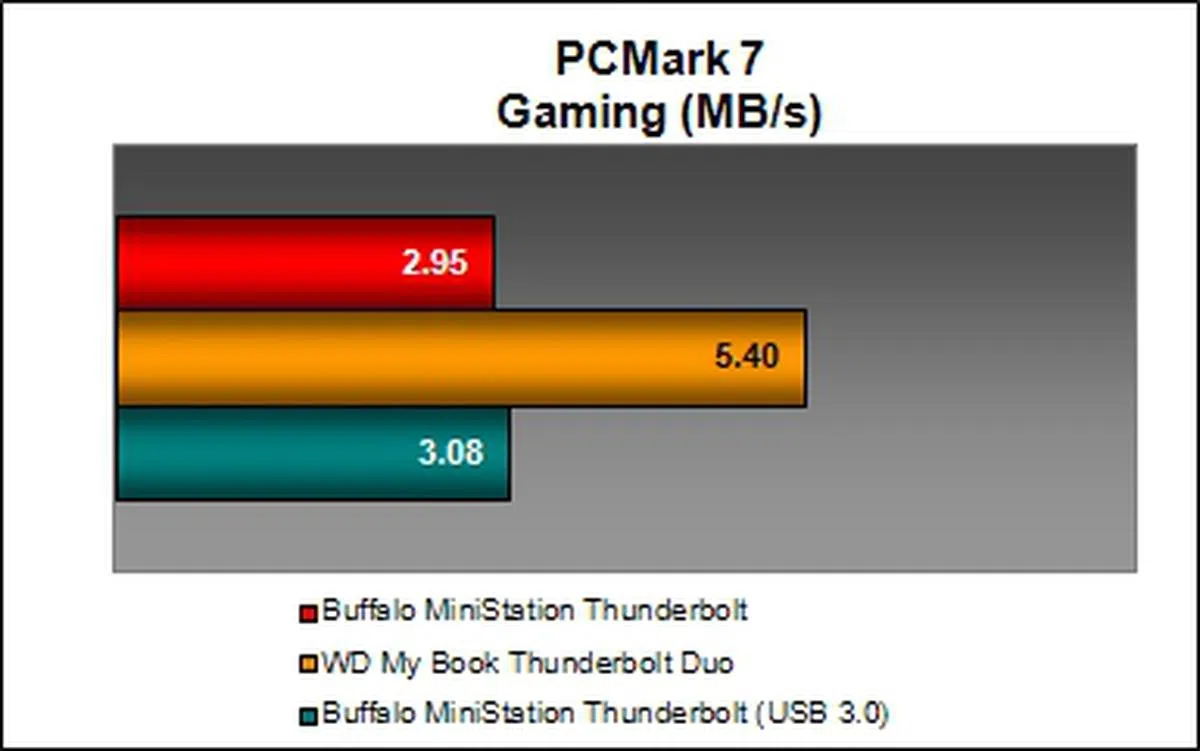 |
Futuremark PCMark Vantage Results
Once more, the Western Digital My Book Thunderbolt Duo was leading PCMark Vantage results by a good margin, which proves that the storage medium used plays a big difference once the interface used is no longer a bottleneck. Given the choice of Buffalo MiniSation Thunderbolt's standard notebook hard disk drive used within its portable enclosure, it had no choice but to settle for lower performance. Going the SSD route would have costed the prospective buyer way too much for this amount of storage. For the Buffalo drive, it seems that USB 3.0 is good enough to get the job done.

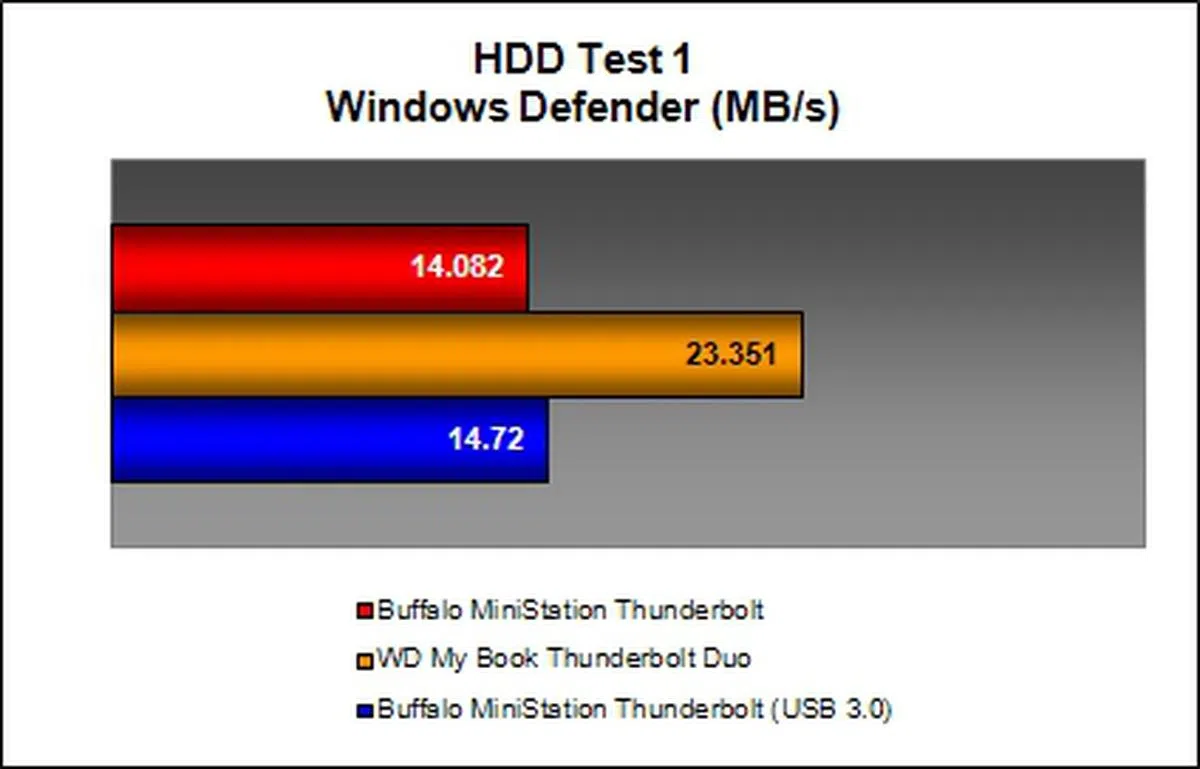 | 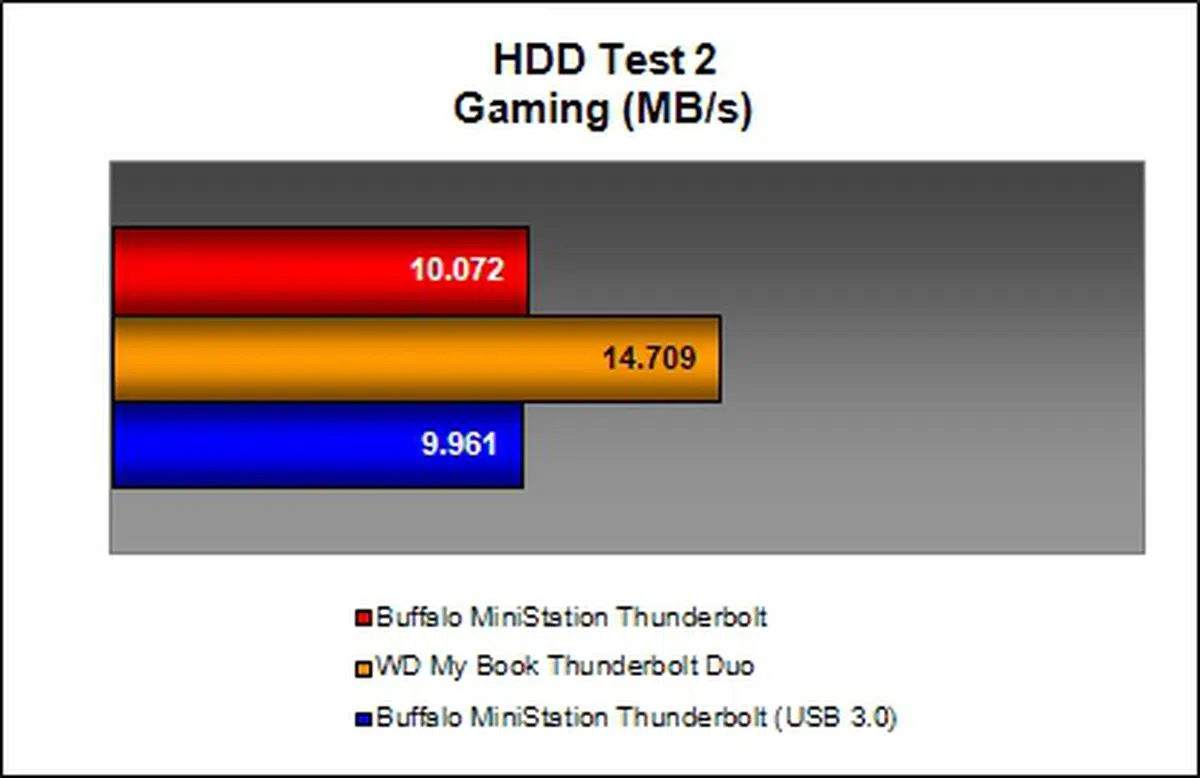 |
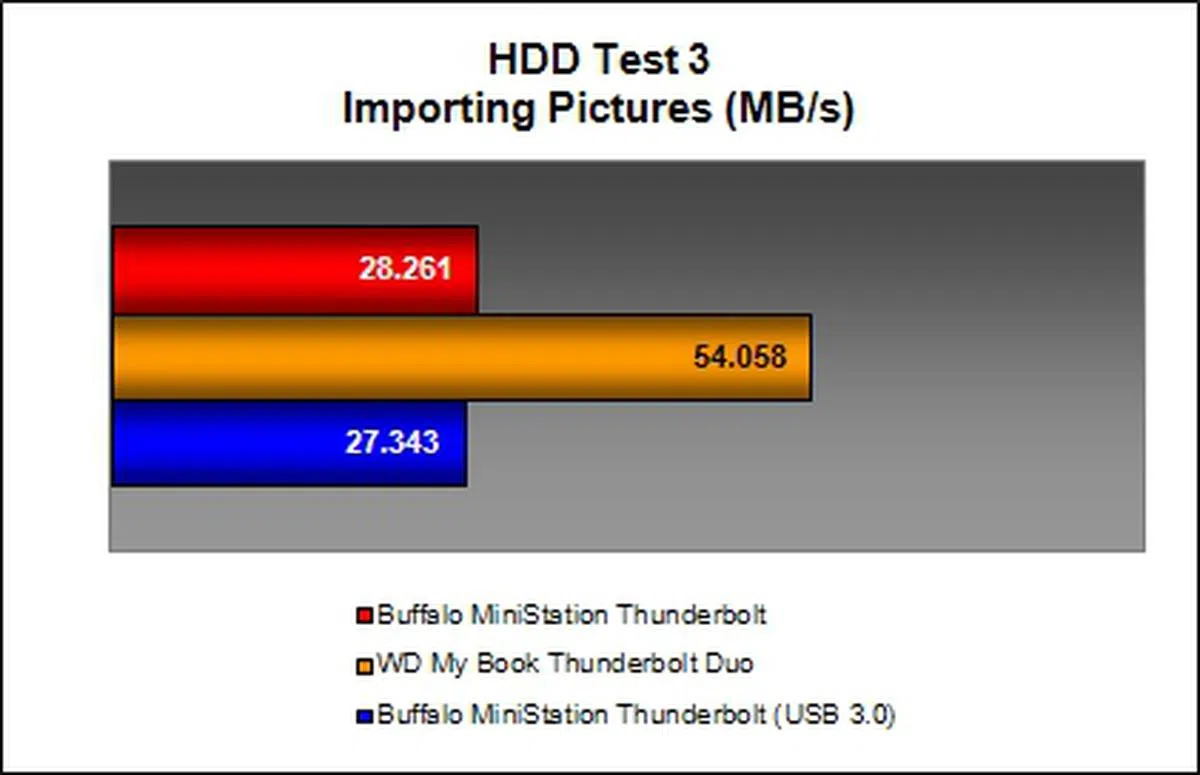 | 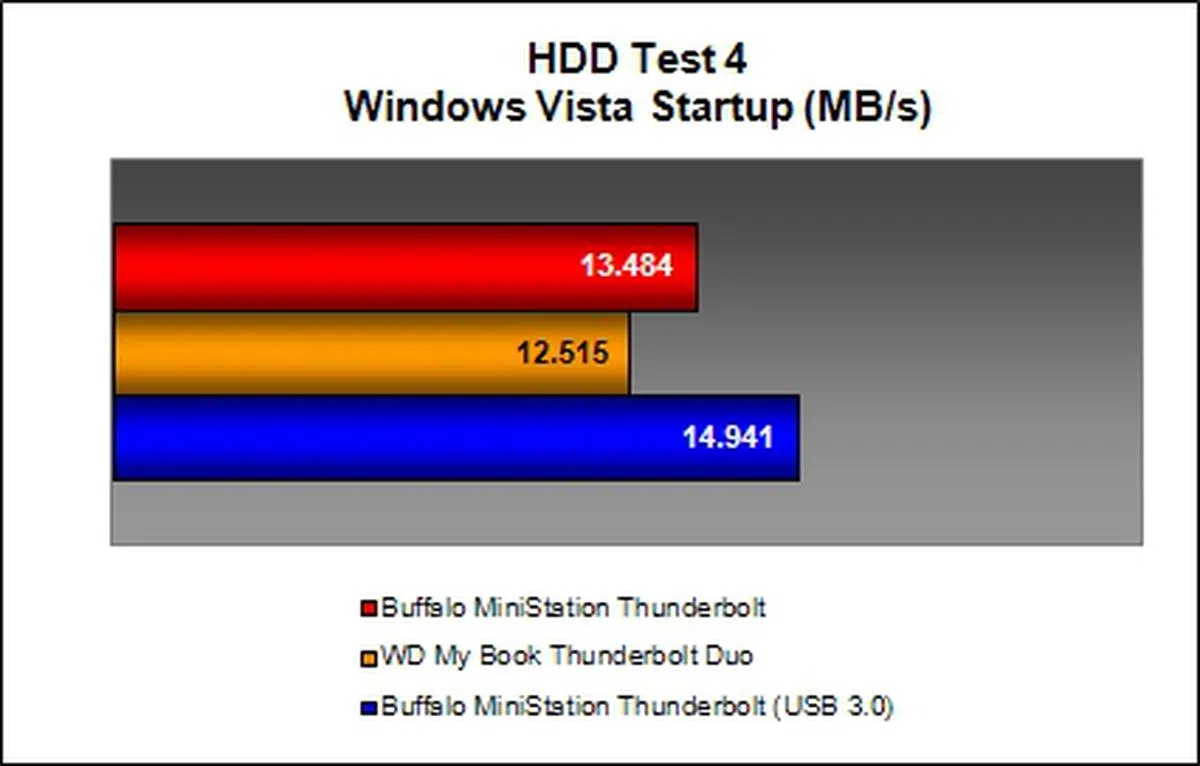 |
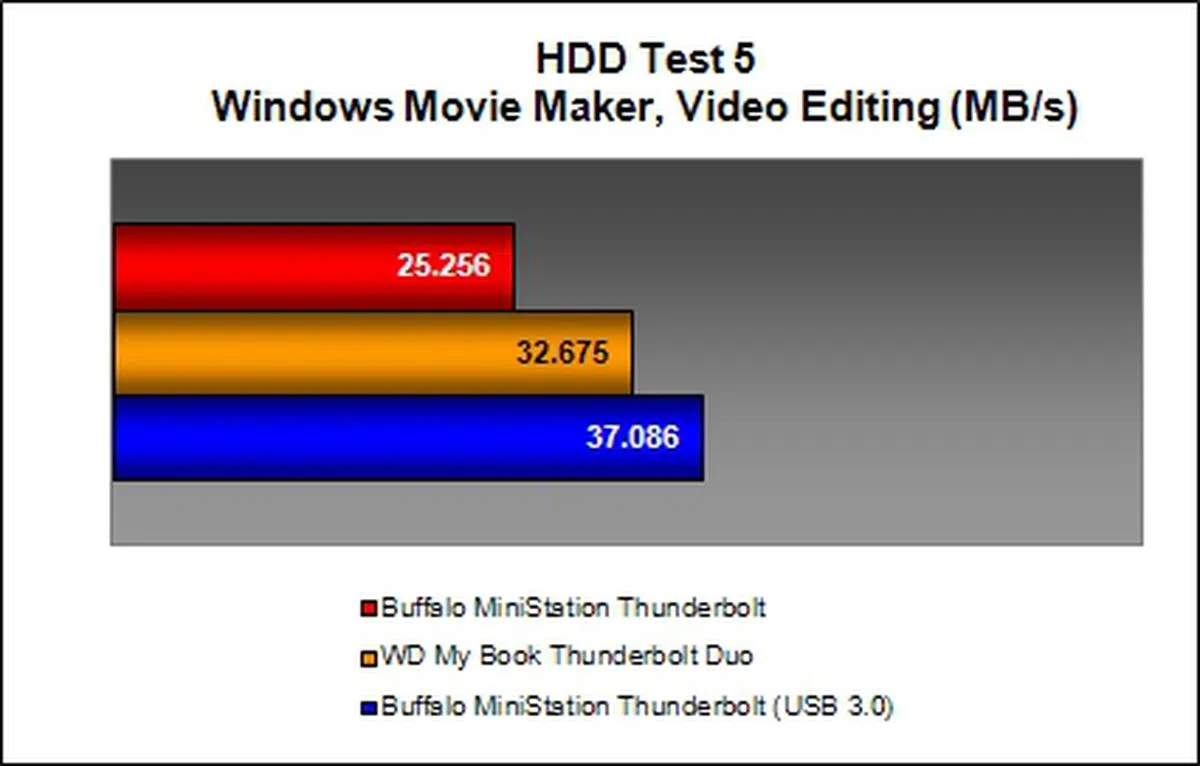 | 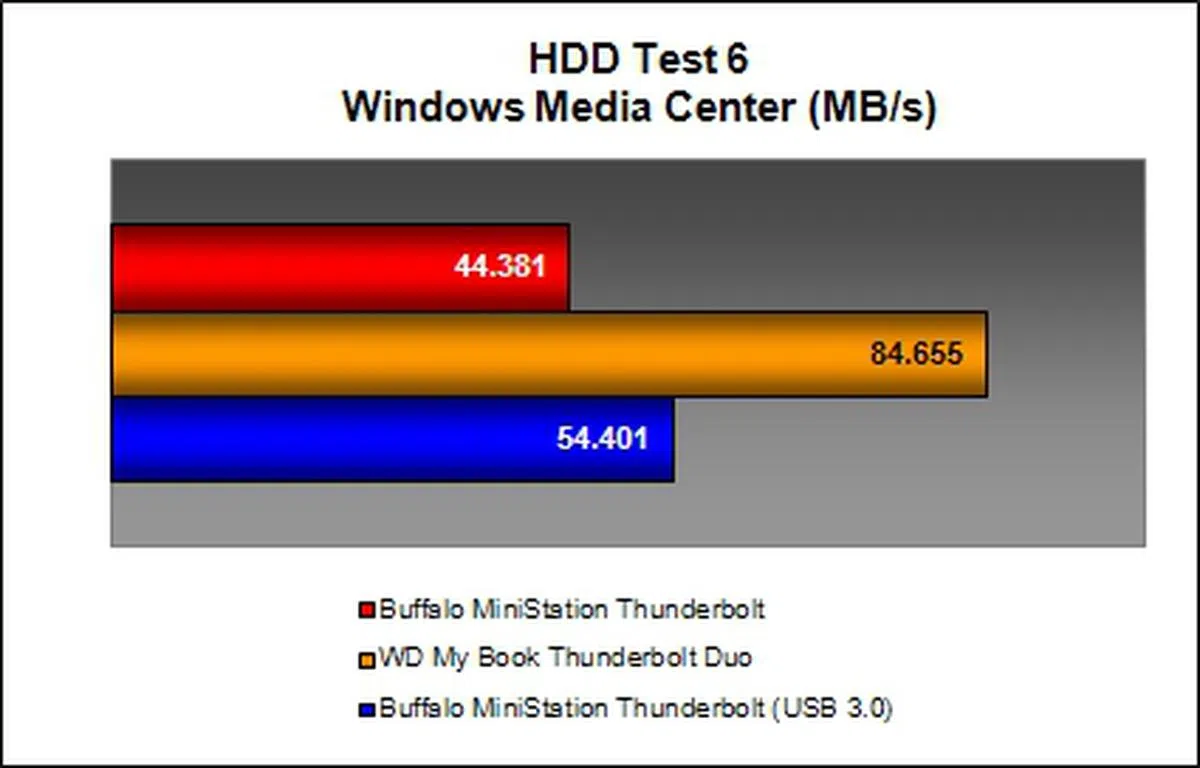 |
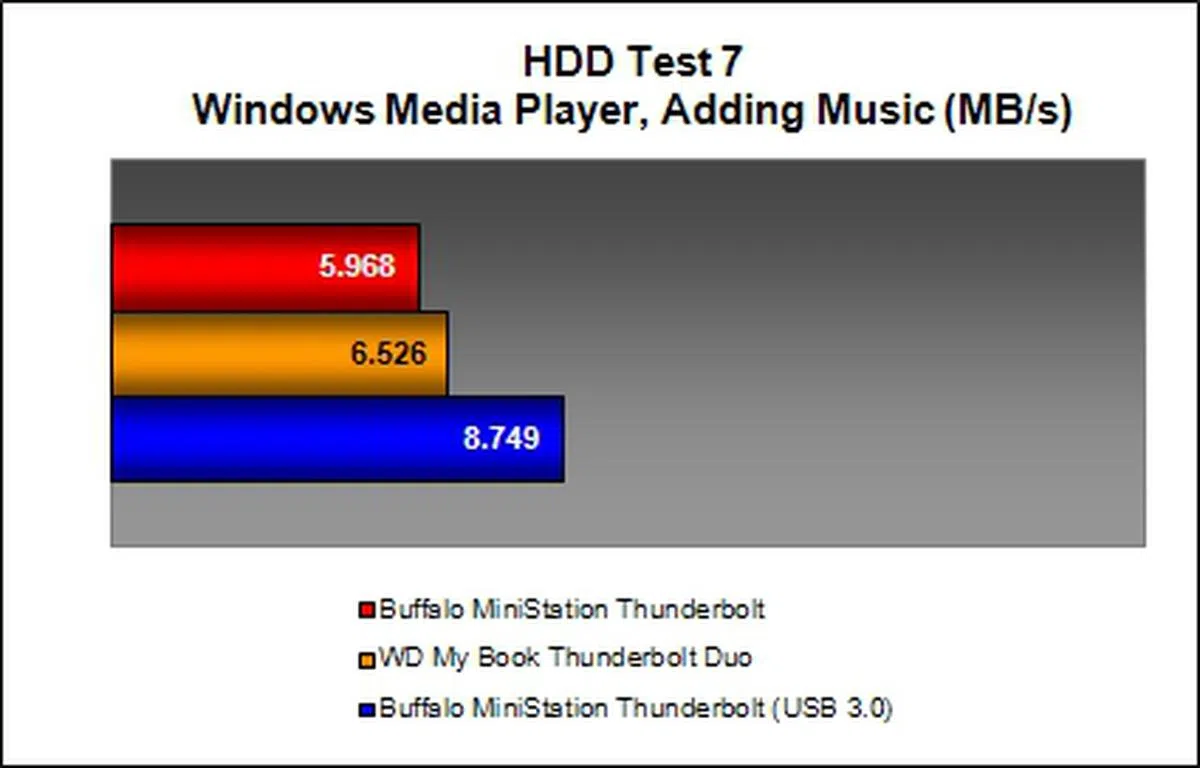 | 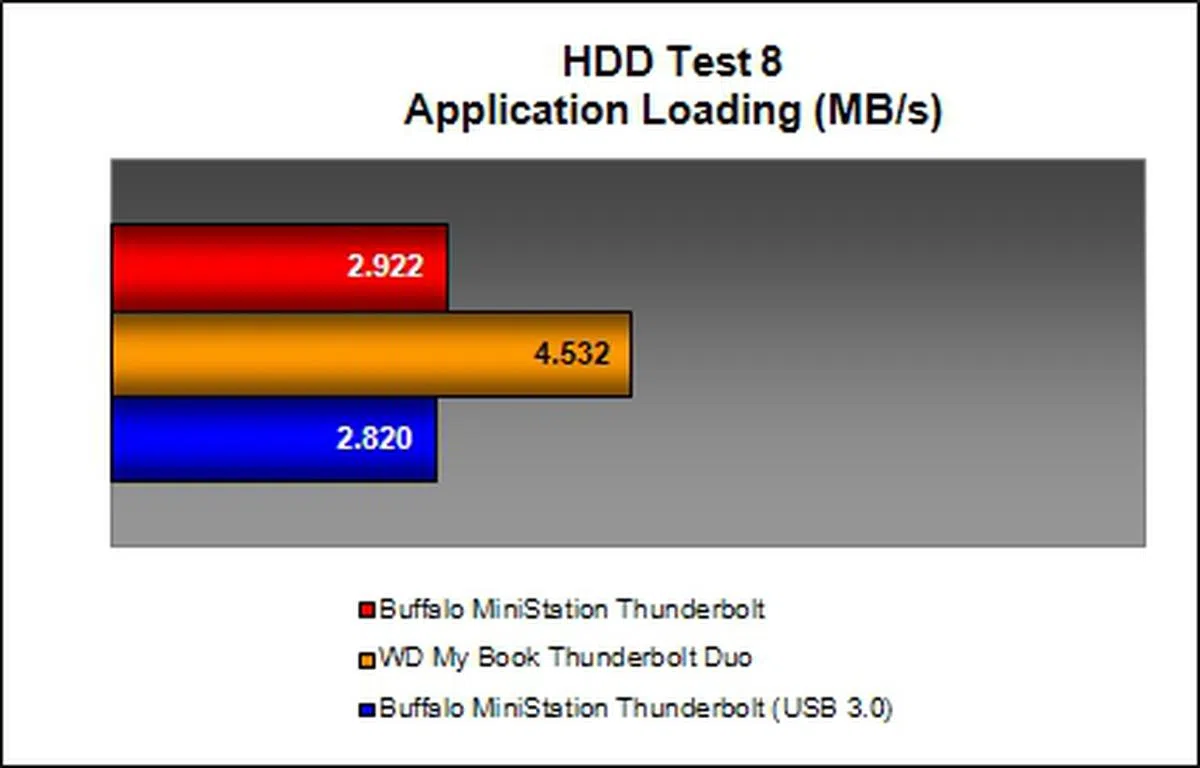 |
Iometer Results (Part 1)
For the grinding I/O tests of this benchmark, Thunderbolt technology fared a wee bit better as its wider bandwidth contributed to the more consistent IOps results in terms of 64K Streaming Reads/Writes operations over increasing queue depths. Unfortunately, the differences in performance turned in by the two interfaces were too miniscule to make any meaningful impact in real-life usage.
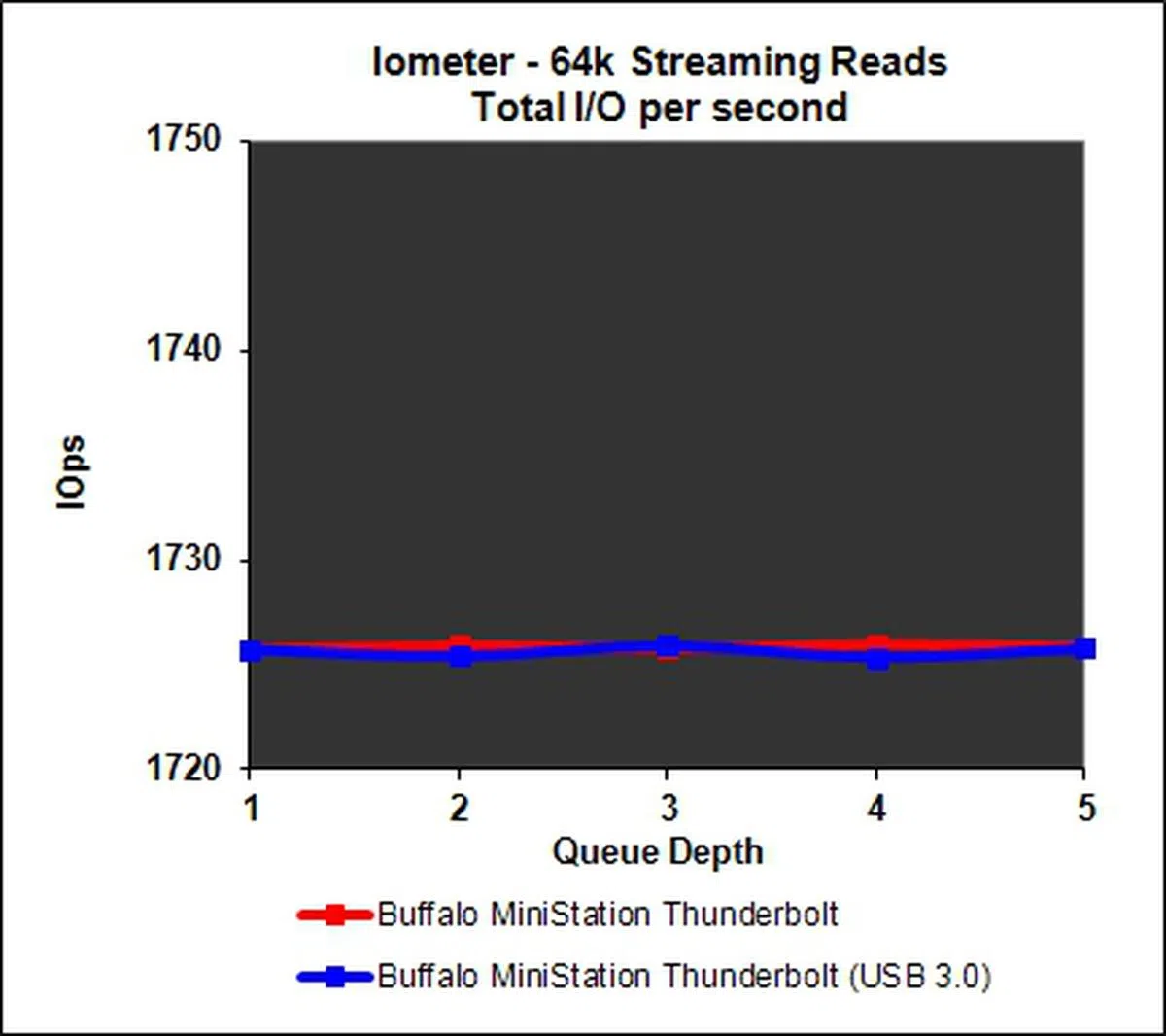 | 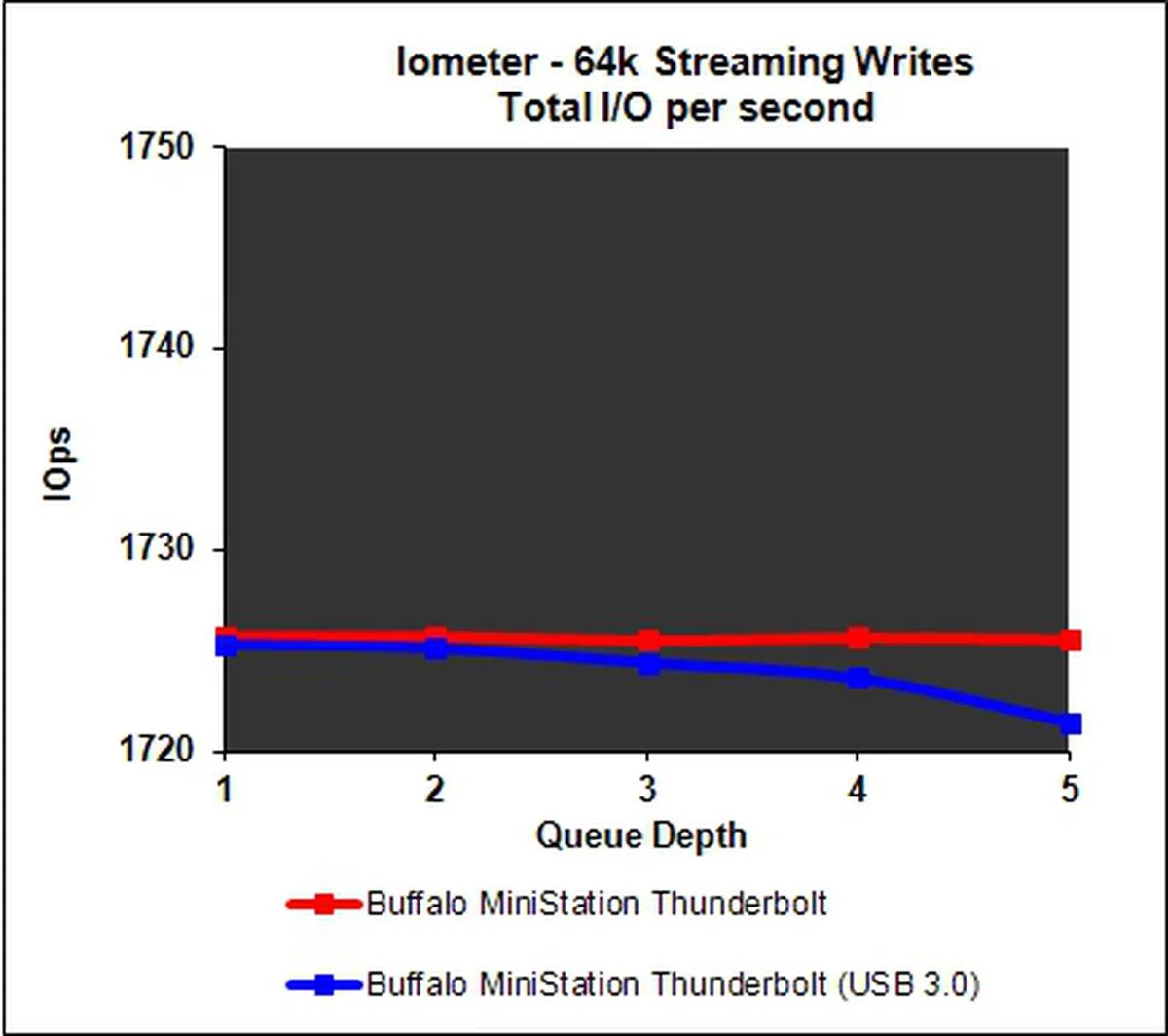 |
The drive performed consistently better on its Thunderbolt interface during the File and Web Servers tests, scaling up consistently as the queue depth was incremented. While it's nice to know Thunderbolt did finally make a small difference, the sad part is that this drive is never going to be used in these kind of workloads to benefit the typical buyer of this product.
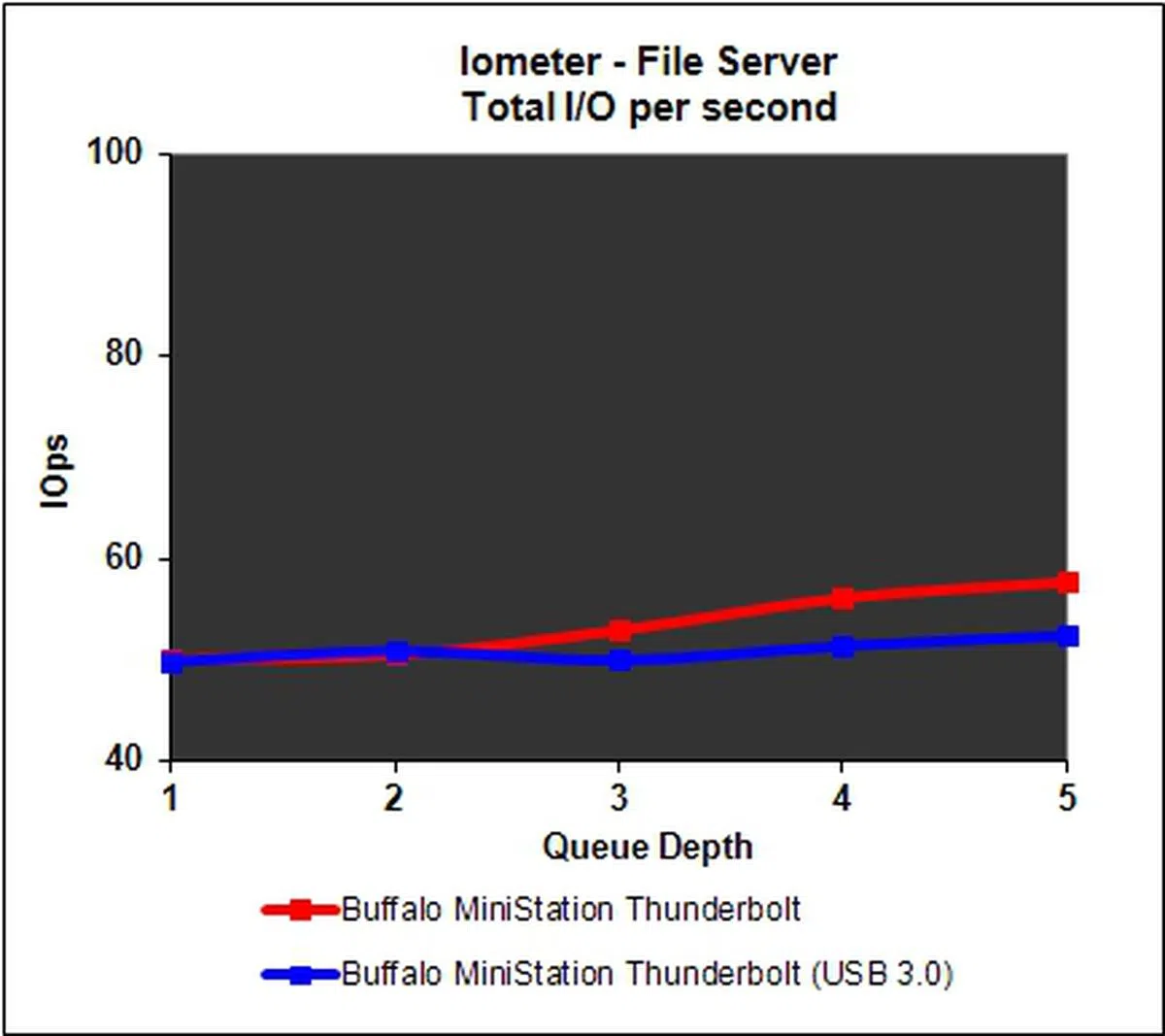 | 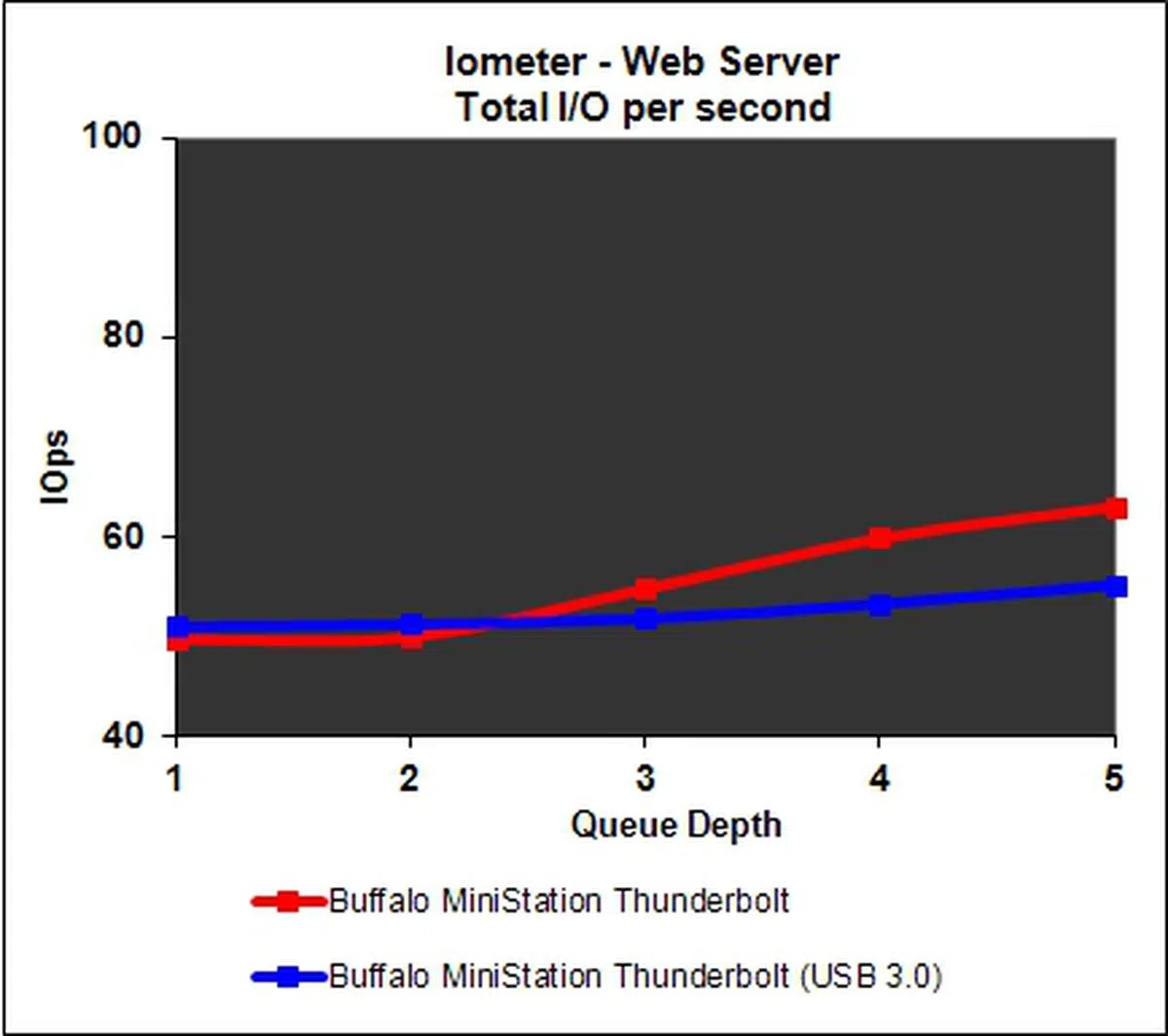 |
Iometer Results (Part 2)
In terms of average response time, there wasn't any marked improvement with the use of Thunderbolt technology. In fact, average I/O response time during 64K Streaming Reads/Writes tests were almost identical to the point their plotted graphs lined up.
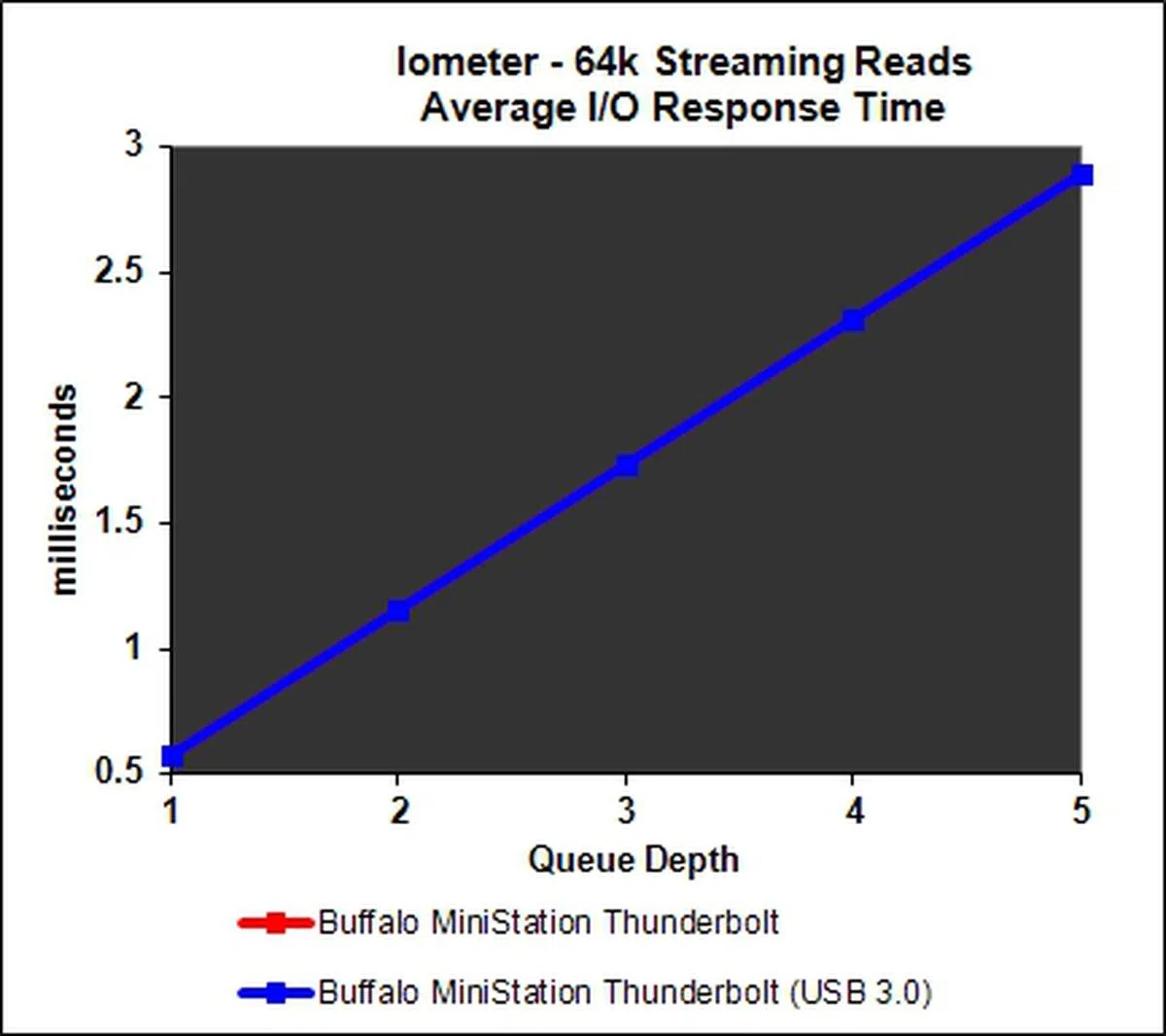 | 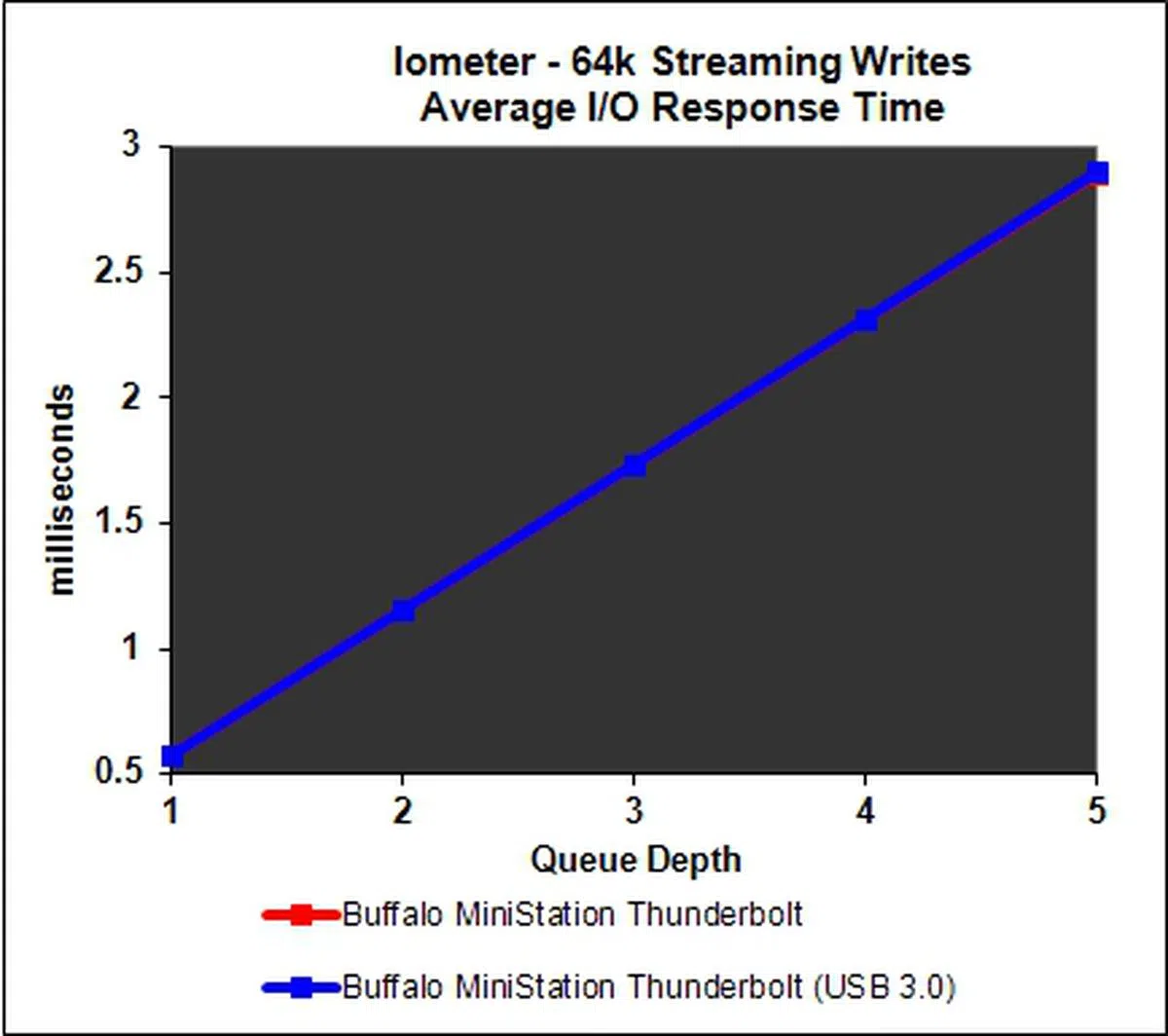 |
There were slight albeit negligible improvements for the File and Web Servers tests as the higher bandwidth of the Thunderbolt ensured the drive's performance, in terms of average I/O response time, scaled consistently as the queue requests increased from one to five. Like we lamented on the earlier page, these tests don't mimic the typical buyer of this product and the tests were conducted to figure out if Thunderbolt made any difference at all.
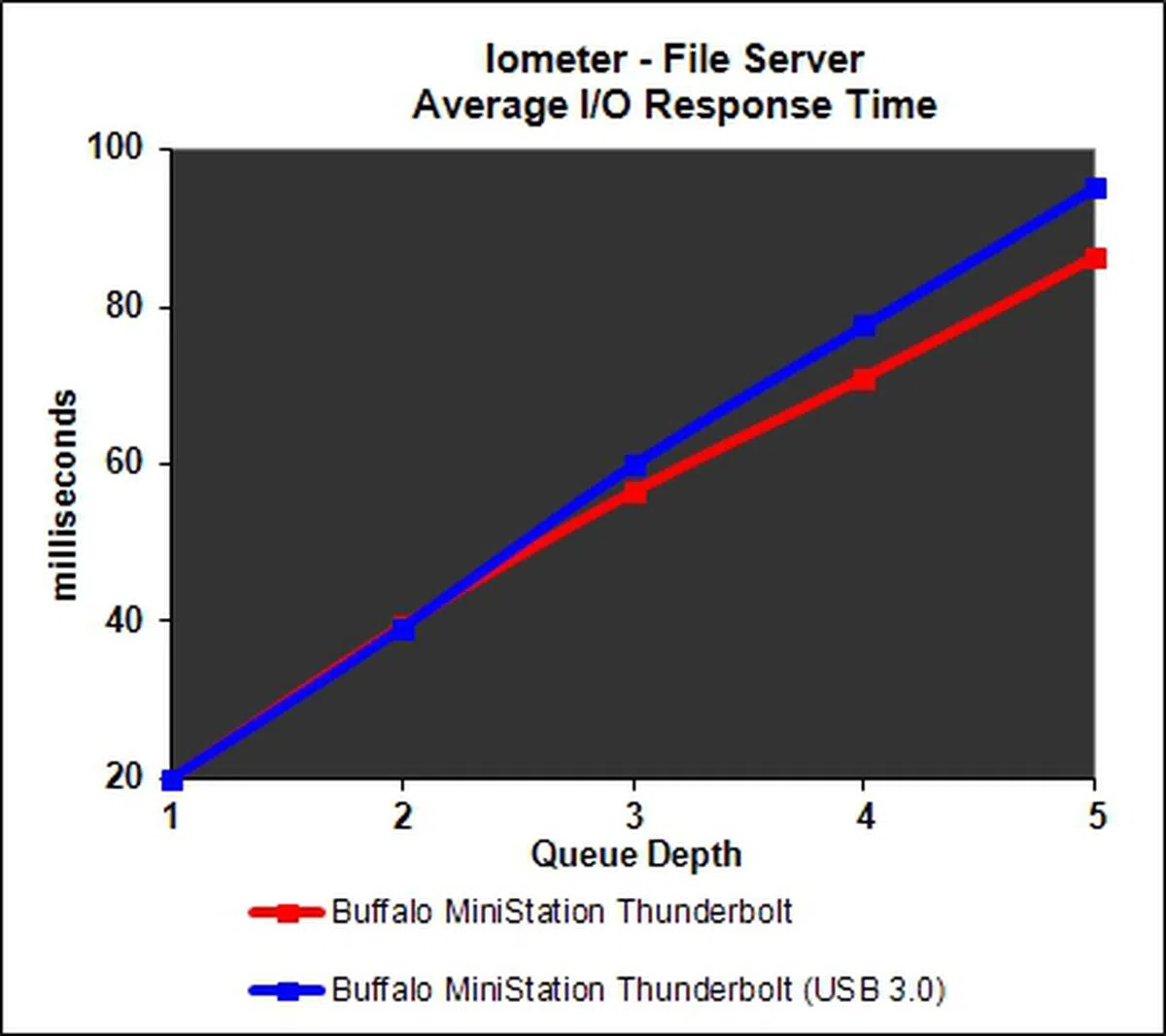 | 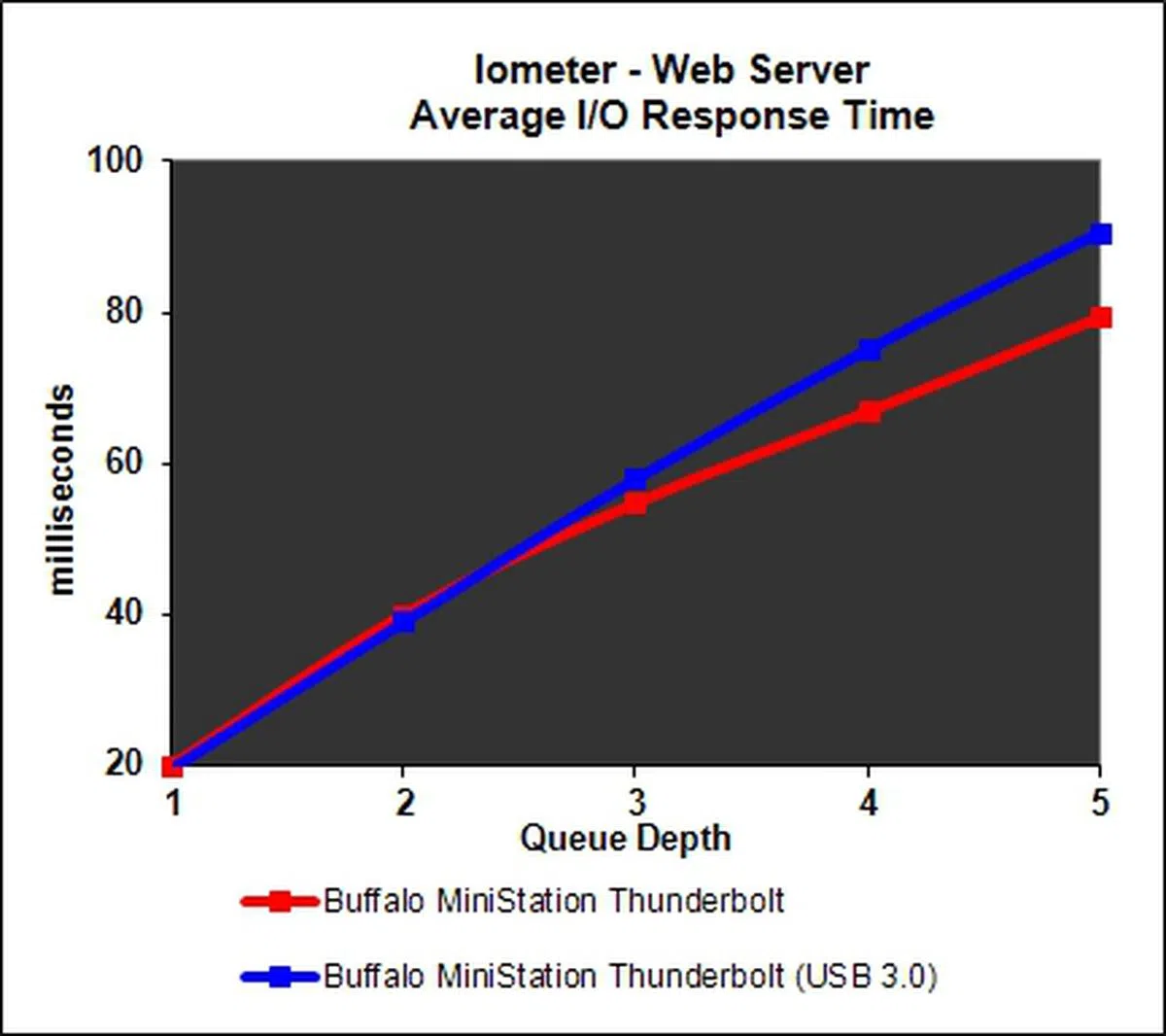 |
Dual Interfaces - A Catch-22 Situation
From the results of the benchmark results, the implementation of Thunderbolt technology on the Buffalo MiniStation Thunderbolt did not impress us. For the most of its results, it lagged behind its older USB 3.0 interface. Any hint of Thunderbolt's performance potential was only vaguely evident in the IOMeter's suite of tests. However, given this benchmark's stressful nature, that's not a typical usage pattern of these portable external drives. In terms of its performance scores turned in from its USB 3.0 interface, we noted earlier that it fared much better than its Thunderbolt interface on most occasions and equaled Buffalo's own MIniStation Extreme, but a little slower than the other recent Thunderbolt-capable Seagate Backup Plus Portable HDD. In one benchmark, CrystalDiskMark, the Buffalo MiniStation Thunderbolt on USB 3.0 actually recorded over 50% higher sequential transfer rates, but it wasn't able to maintain nor reproduce the lead it had in other tests.

Like its soft and muted exterior, the Buffalo MinStation Thunderbolt performance on its Thunderbolt interface wasn't outstanding.
We applaud the efforts of Buffalo in their efforts to bring Thunderbolt to the masses in the form of this portable HDD drive that smacks of Apple's post-industrial look-and-feel design touches. The company even bundled a copper Thunderbolt cable, its thoughtfulness is much appreciated as we have had encountered Thunderbolt-enabled storage devices that shipped without this essential cable. However in terms of overall portability, the drive's integration of Thunderbolt electronics has added extra weight and bulk to the overall unit and doesn't compete well with other drives that concentrate on just one interface and maintain a slim figure. In fact, given that Thunderbolt didn't really help the drive, its characteristics come at an expense versus that of the competition which made it optional and maintained better portability.
What we are truly puzzled is by the company's decision to pair a 5400RPM SATA 3Gbps notebook HDD with Thunderbolt interface as the drive did evidently do injustice to the dual-channel theoretical bandwidth of 10Gbps that the new interconnect technology offers. It would have been a much better coupling if Buffalo had decided to use a SSD instead. That would however inevitably drive up the price of of the drive to over S$700 for the same 500GB capacity point. As a go-between, Buffalo should have opted for a high performance notebook hard disk drive to better utilize the speedier interface if their goal was to provide large capacity at a reasonable price point.
Yet another letdown is the fact that there is only a single Thunderbolt interface available, restricting the drive's ability to daisy-chain. So if you've only one Thunderbolt port in your system, you would probably think twice using it on this interface, further reducing the usability and advantages of the Thunderbolt interface.
The Buffalo MiniStation Thunderbolt, as a drive, is a flexible portable storage device with its option for either USB 3.0/2.0 and Thunderbolt as an interface. In terms of its absolute price point (SRP: S$279 for 500GB and S$349 for 1TB), it is an expensive device for a consumer to jump onto the Thunderbolt bandwagon with the caveat of its paltry performance as a Thunderbolt-enabled device. For that price, you could very well obtain a very fast 240GB SSD drive or get a 2TB Buffalo MiniStation USB 3.0-only drive. The choice is yours.
In conclusion, the Buffalo MiniStation Thunderbolt came across as an expensive 2.5-inch, USB 3.0 portable HDD but its Thunderbolt feature would allow its owner some bragging rights as an early adopter of this new interconnect technology (even if it offers no advantages in this implementation).
Our articles may contain affiliate links. If you buy through these links, we may earn a small commission.